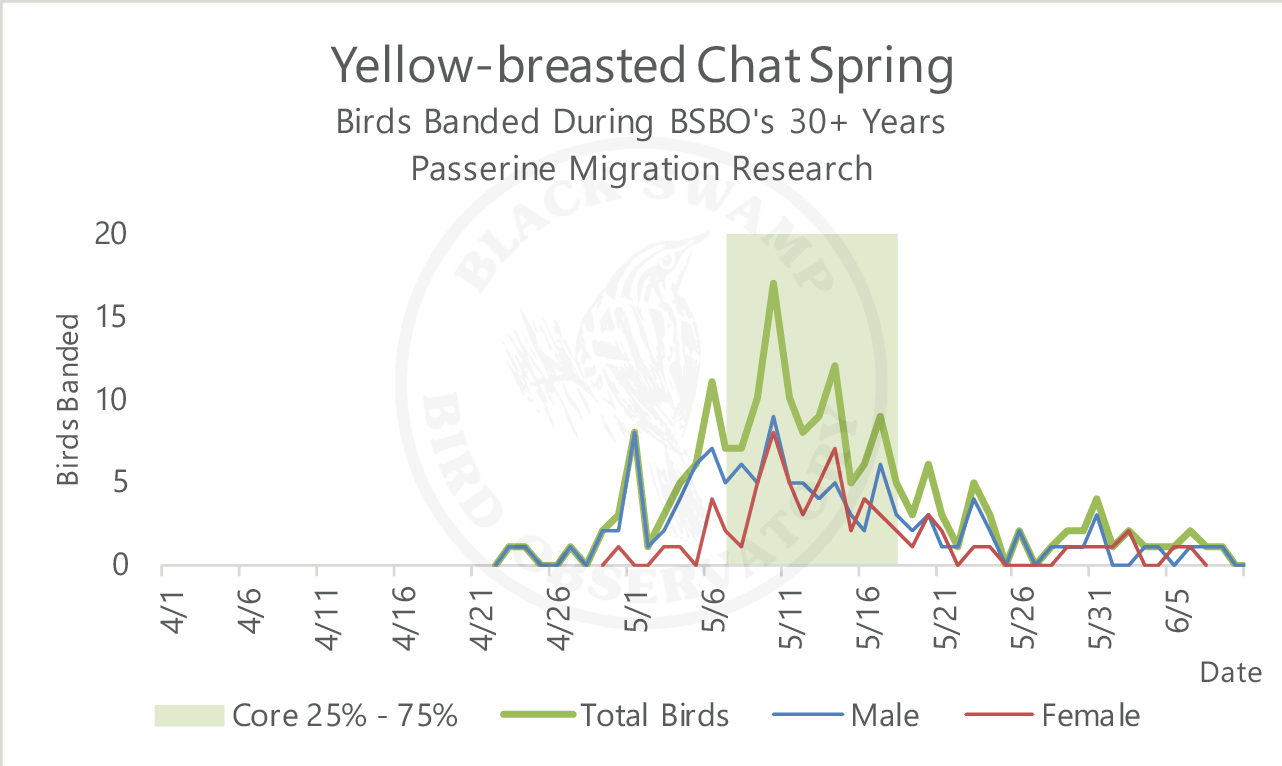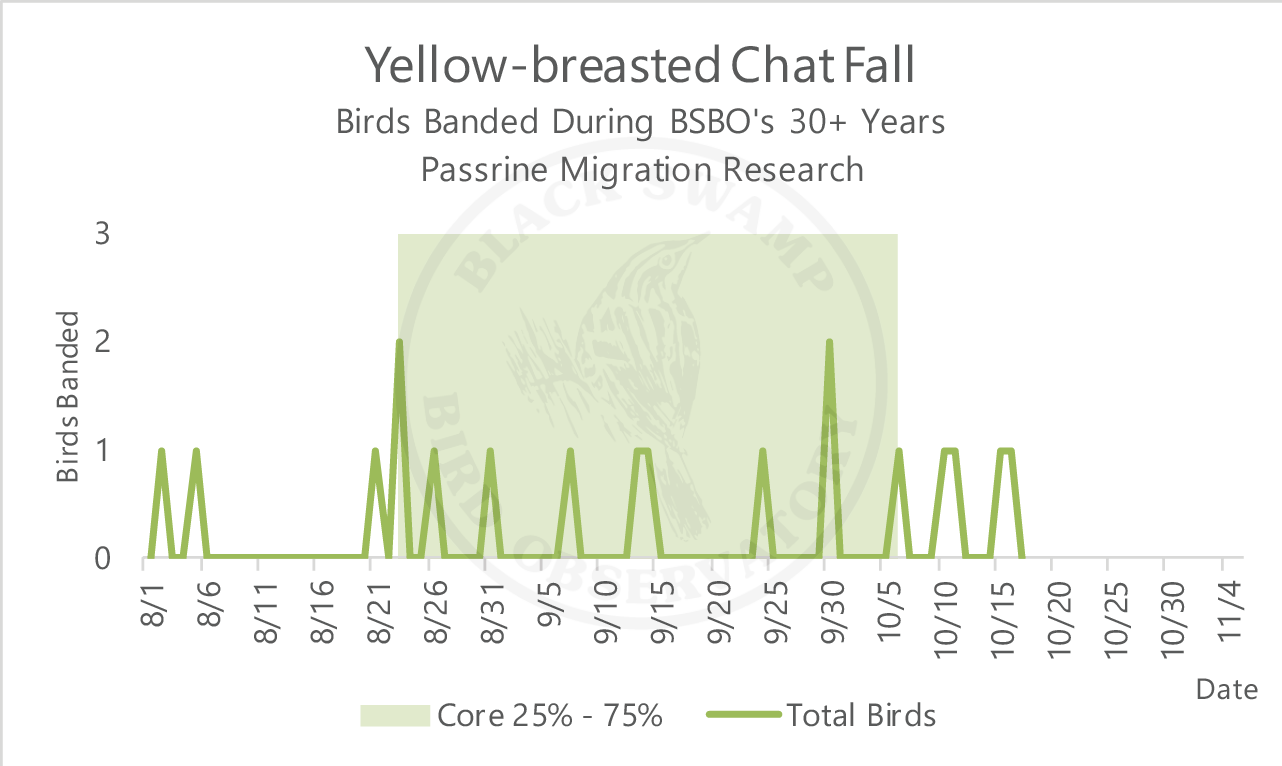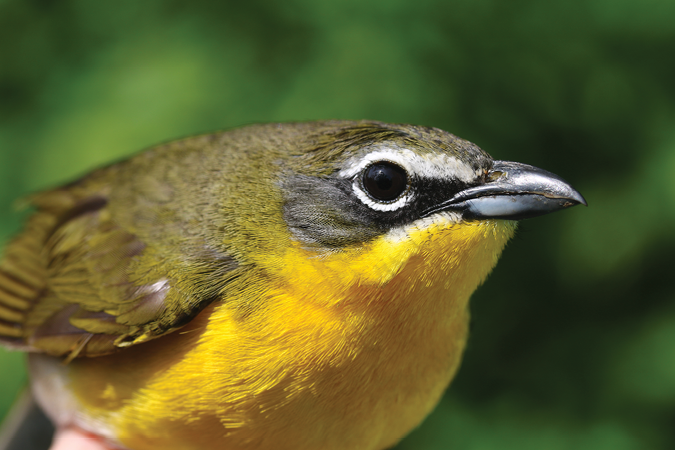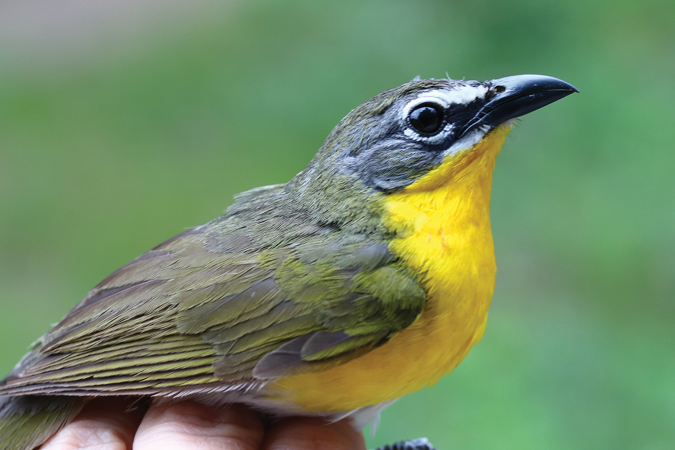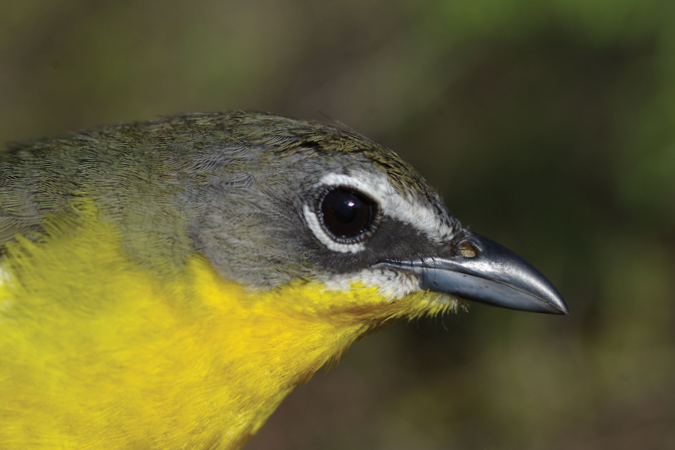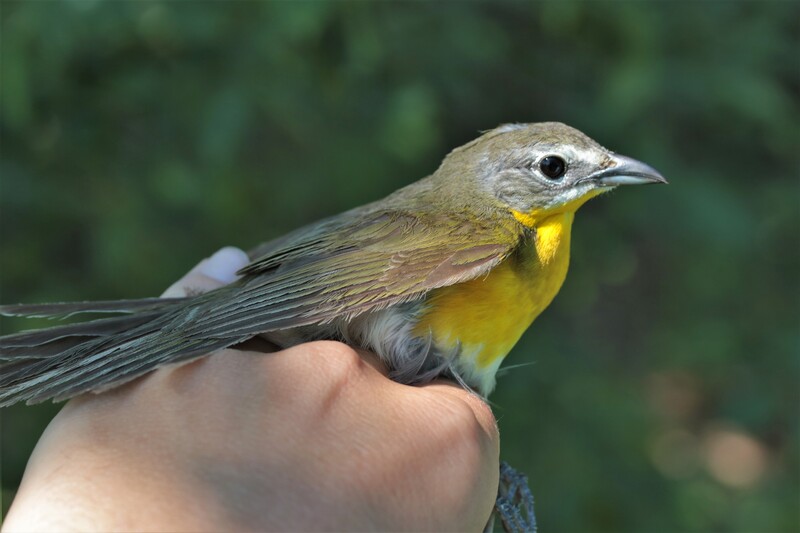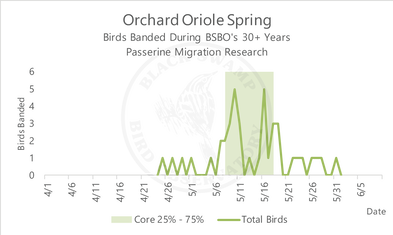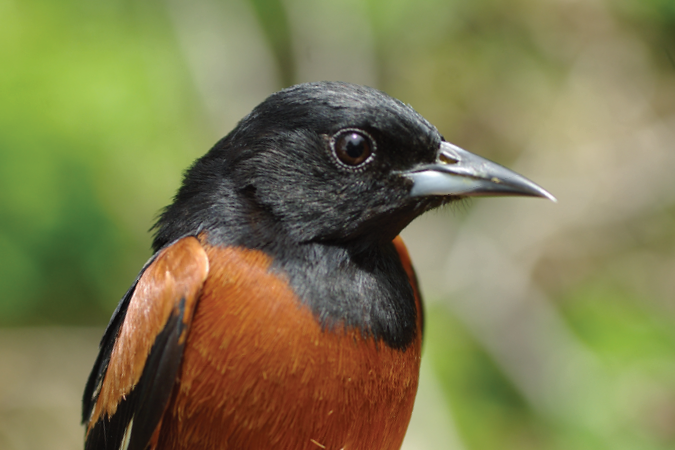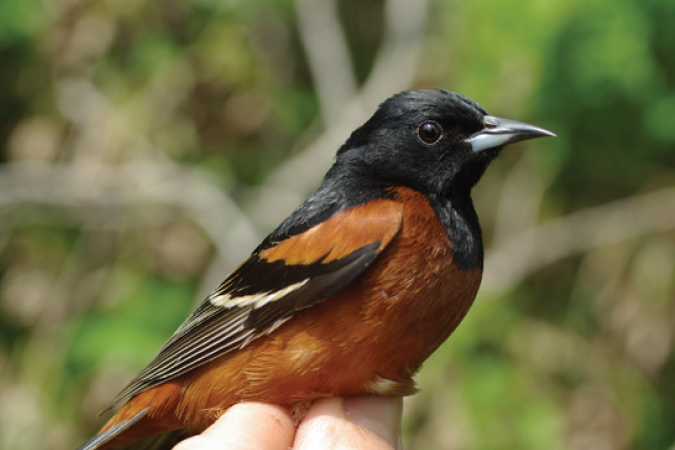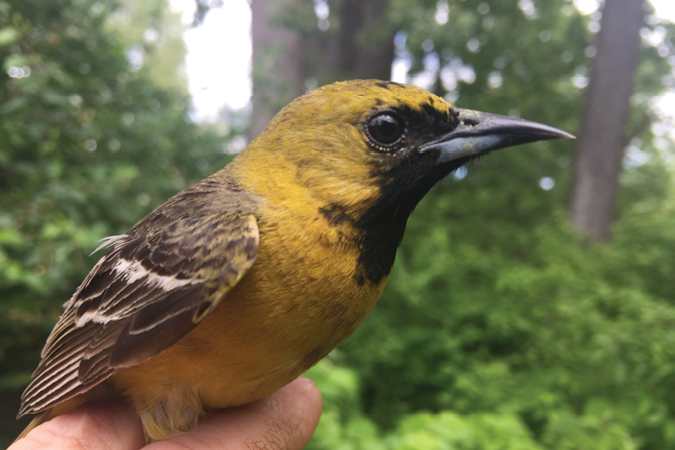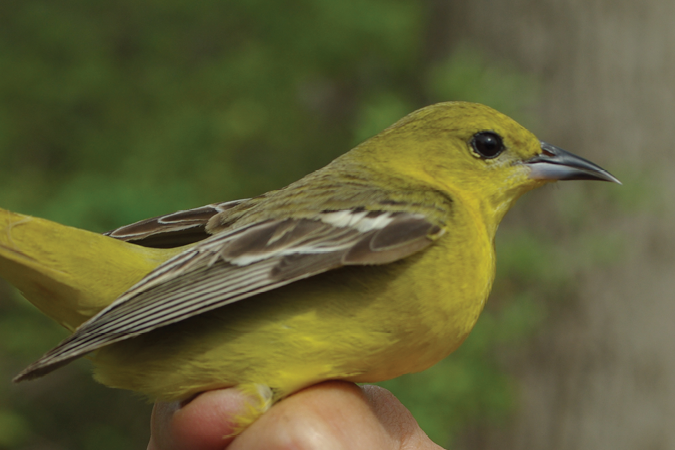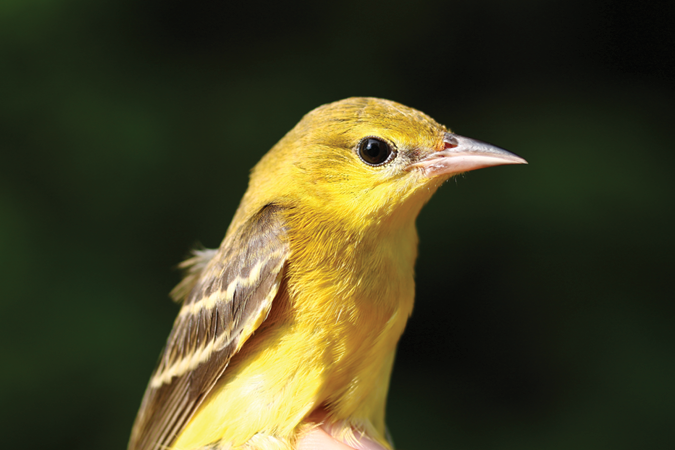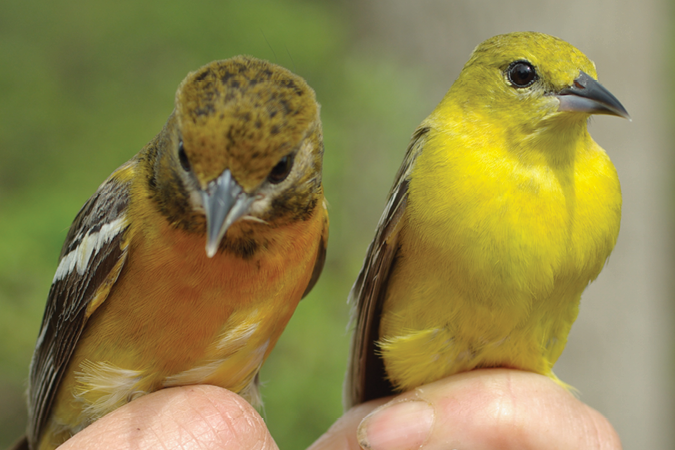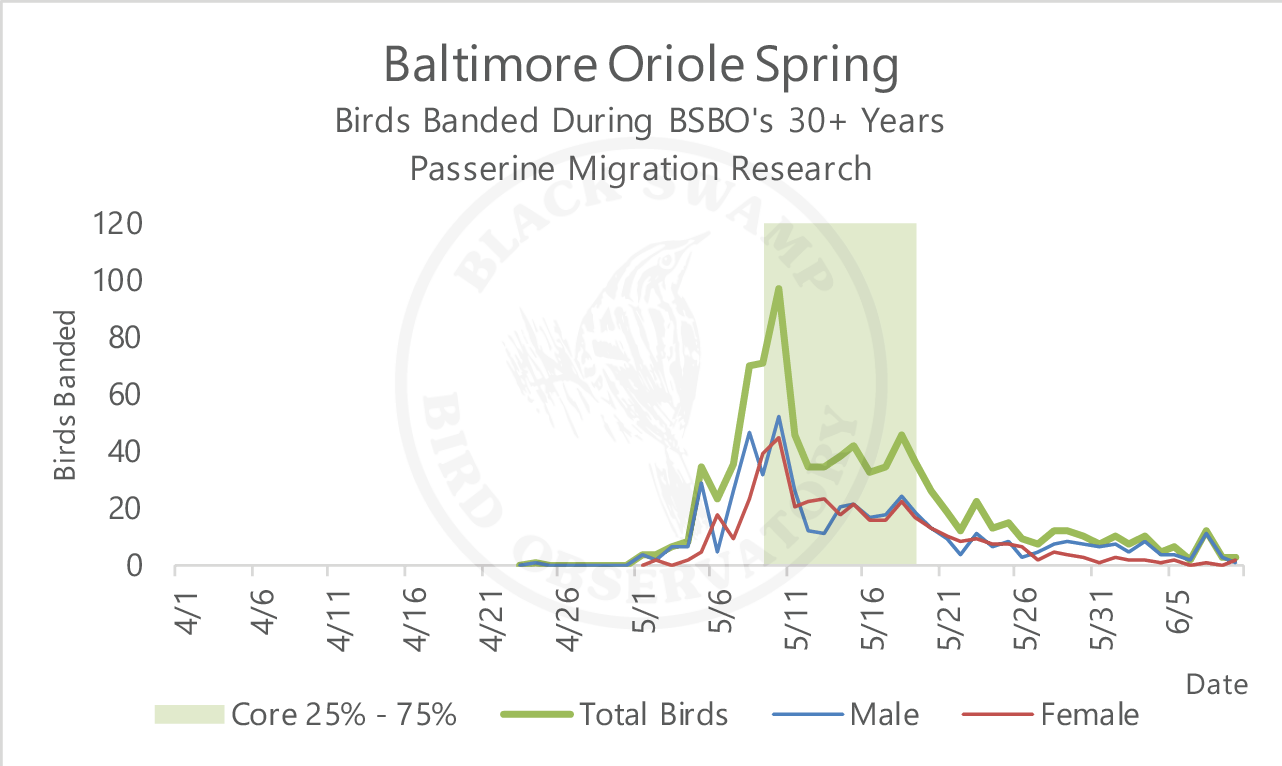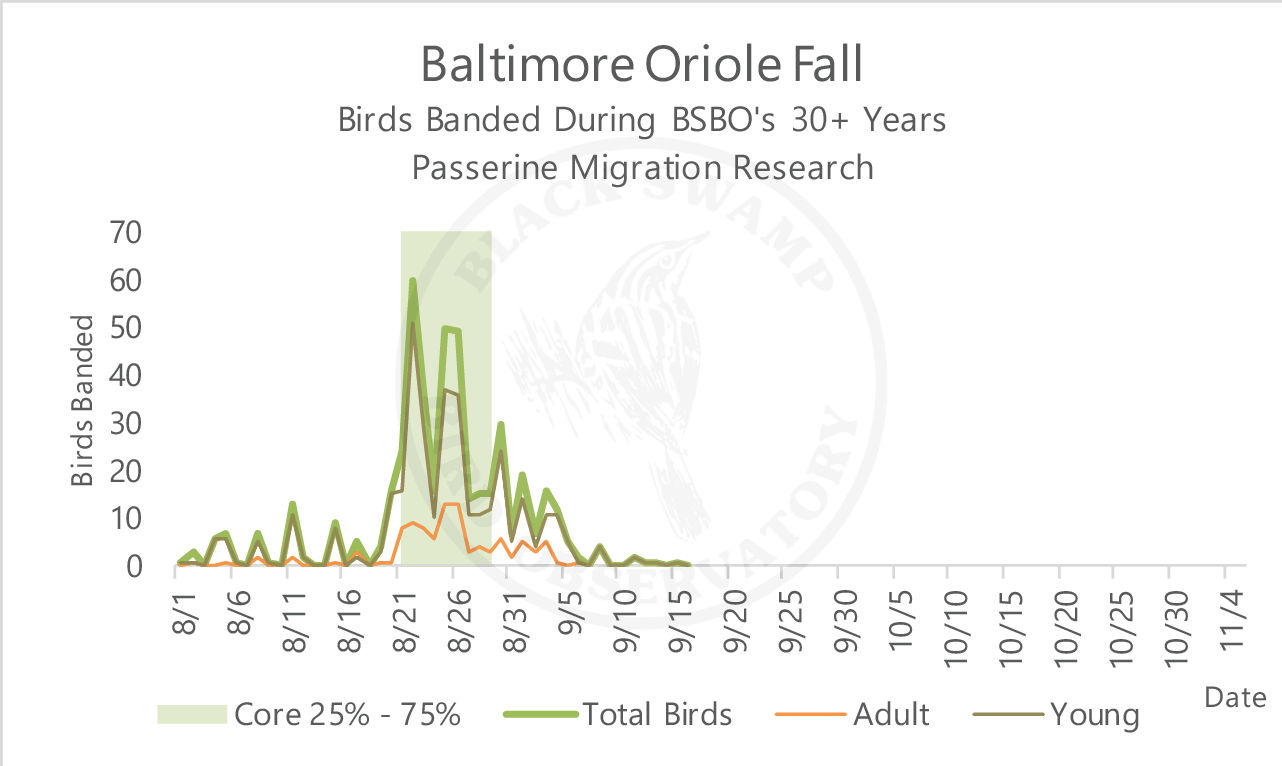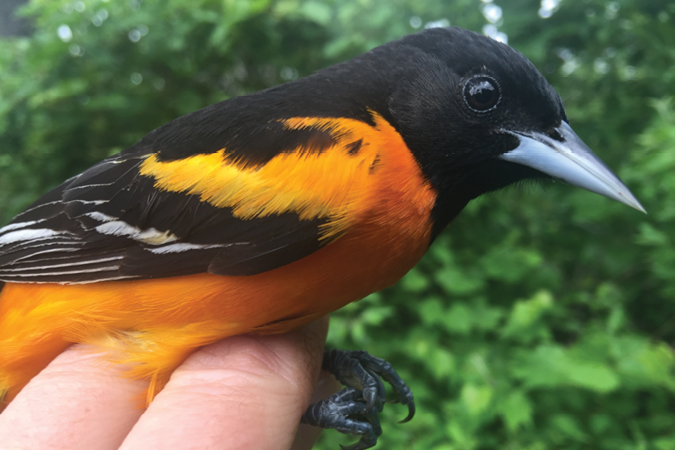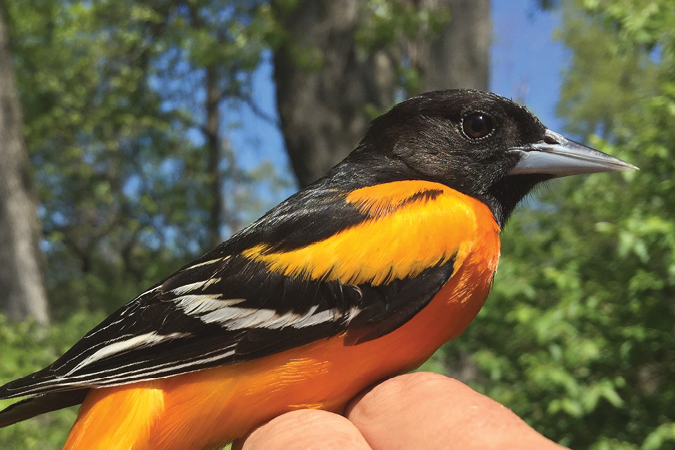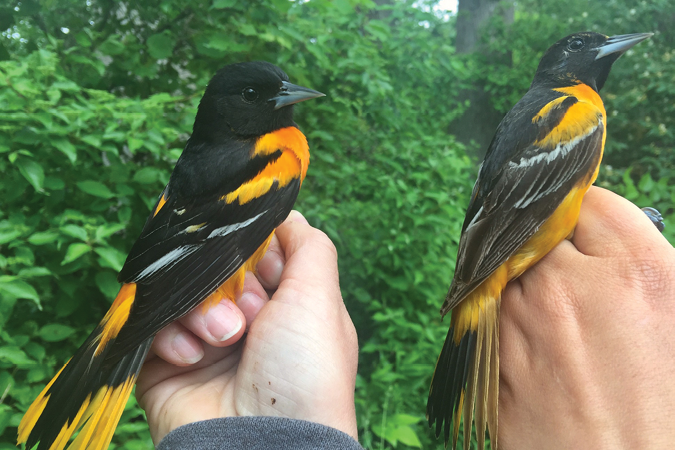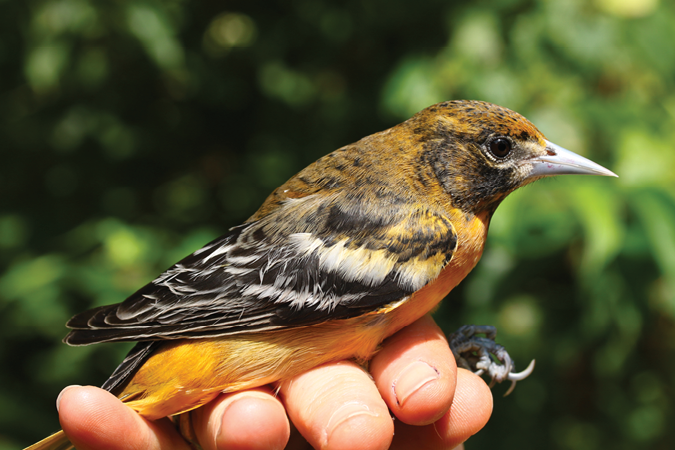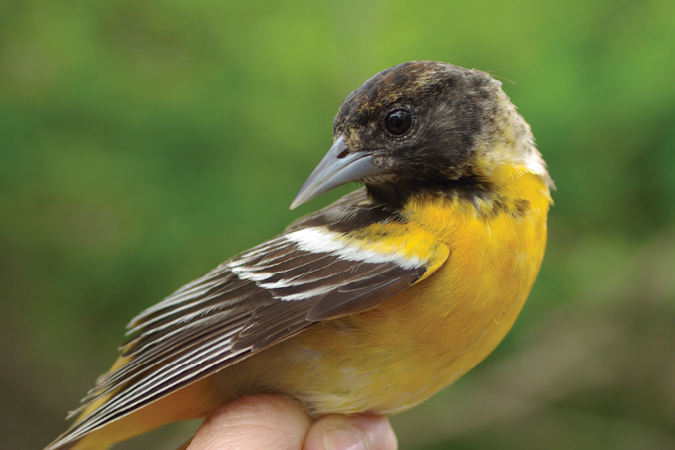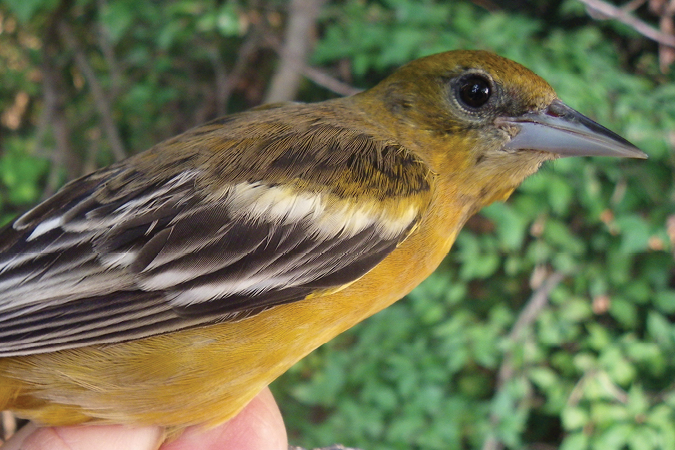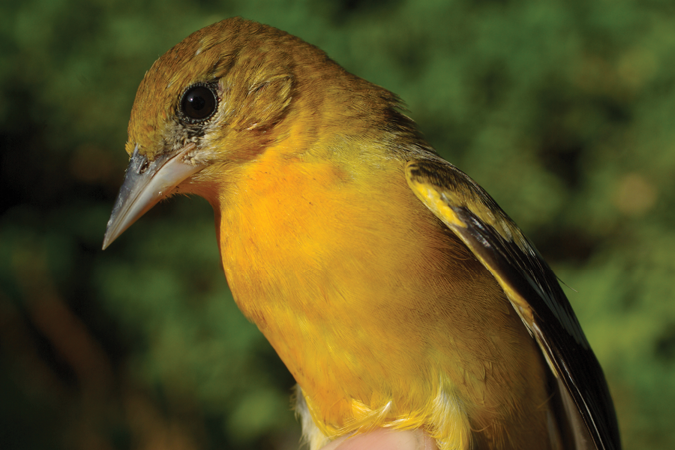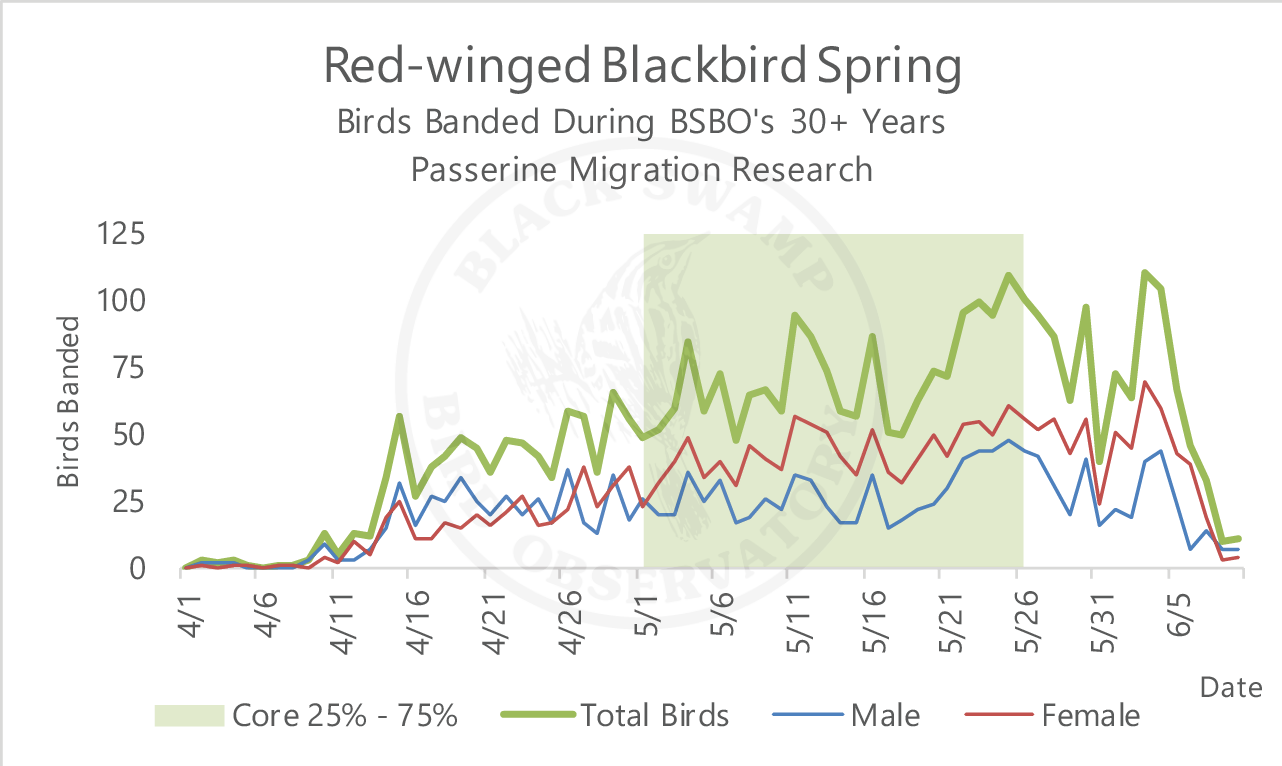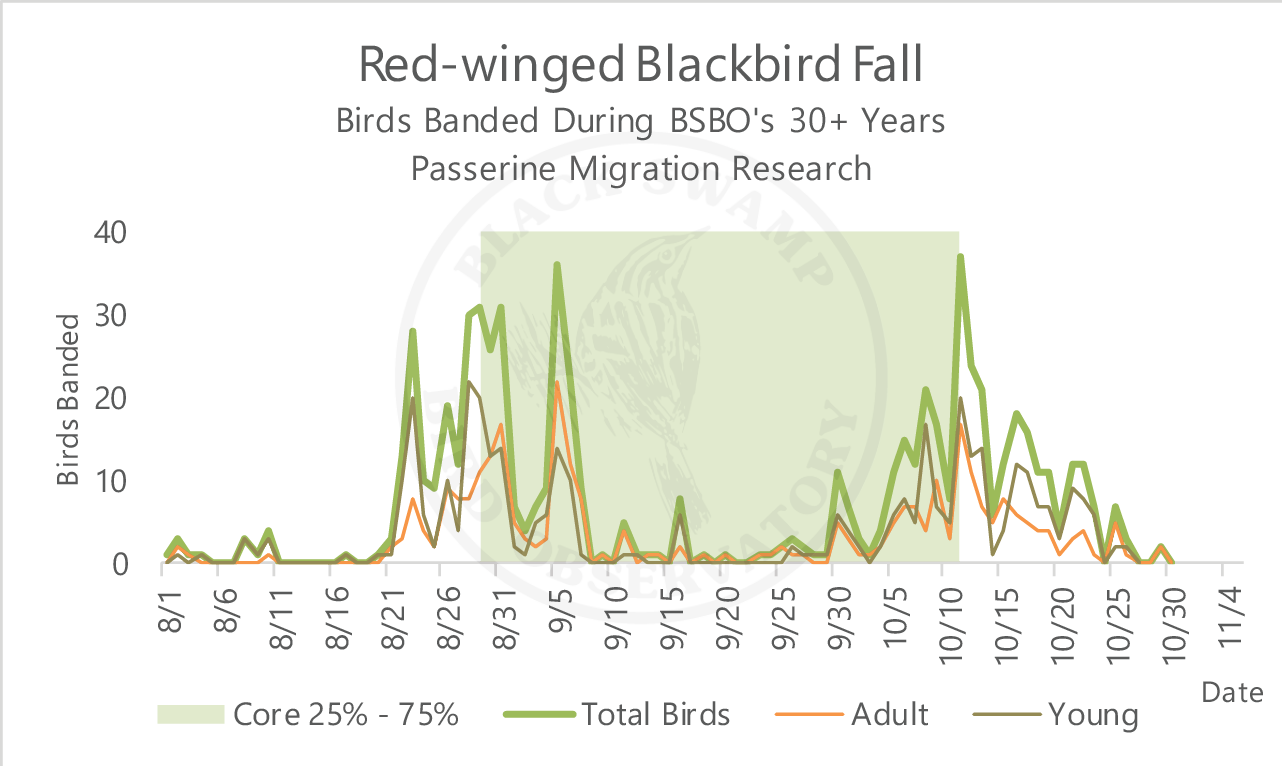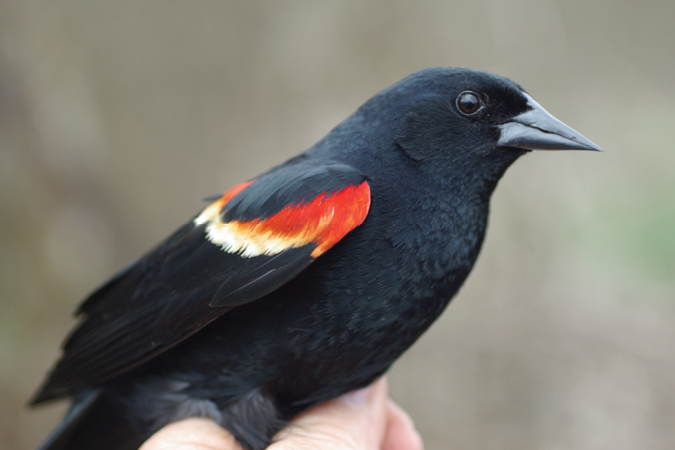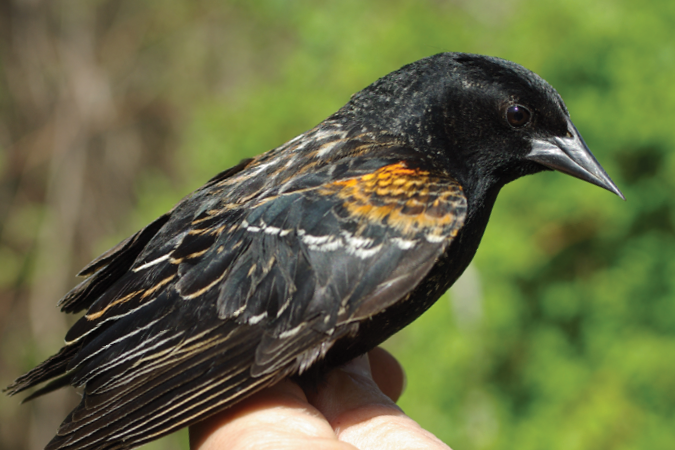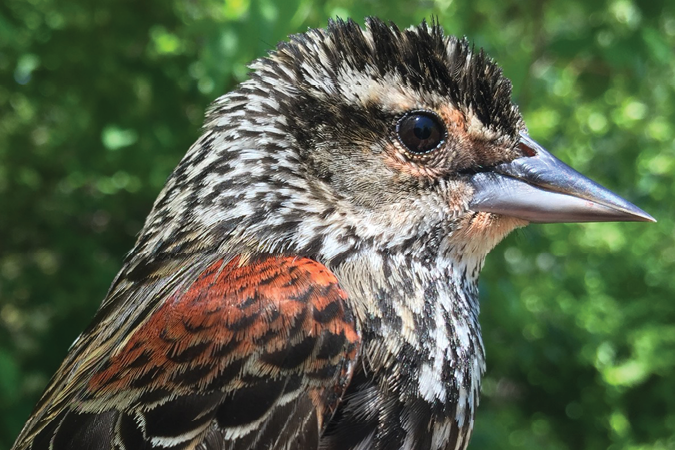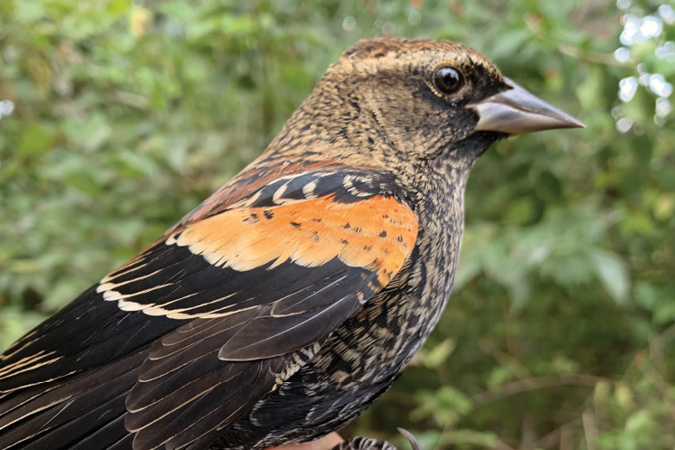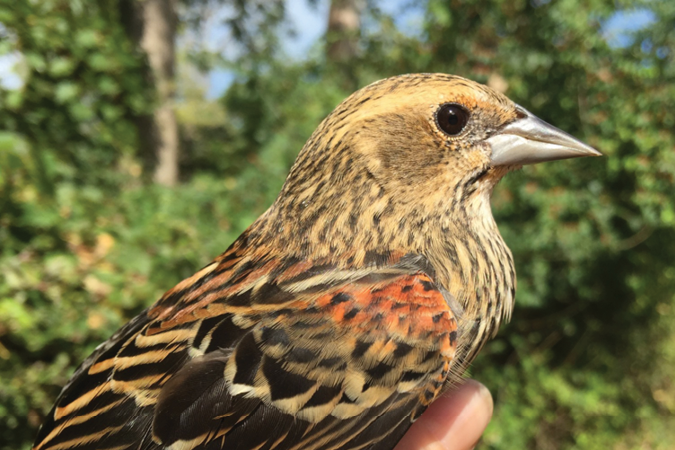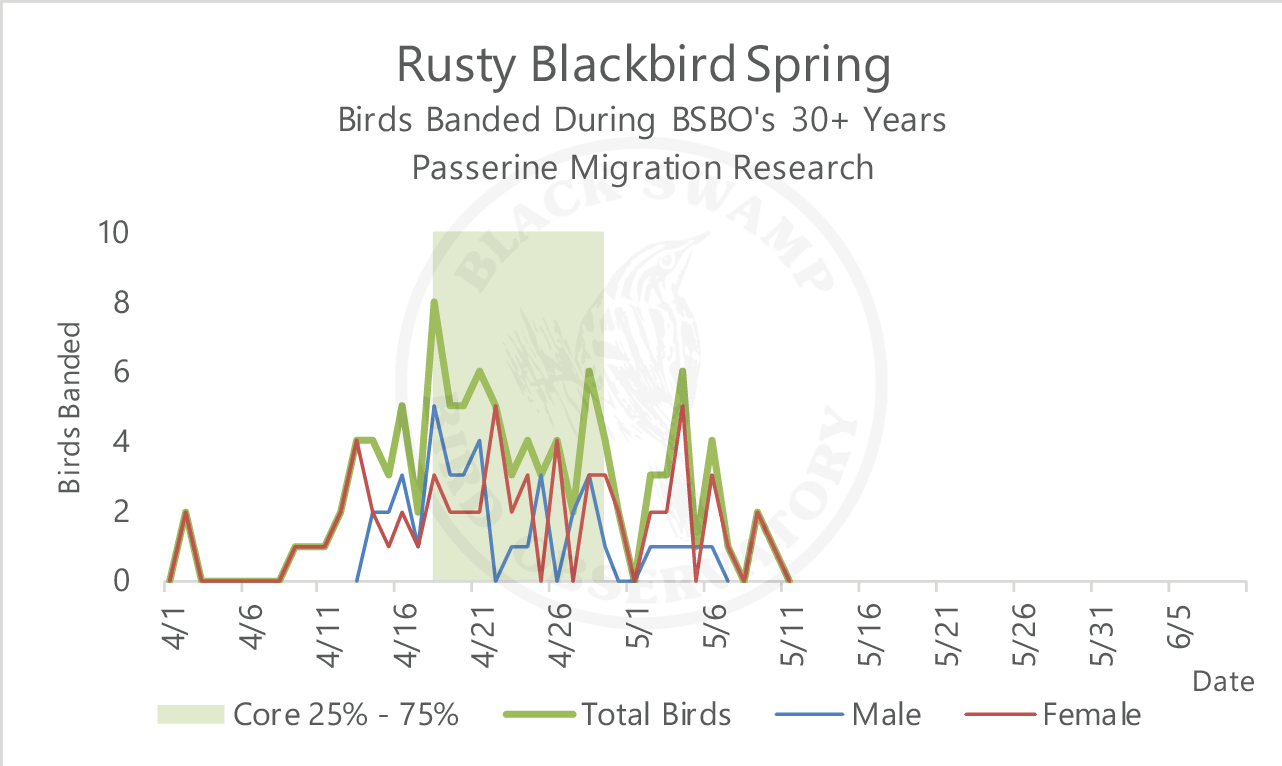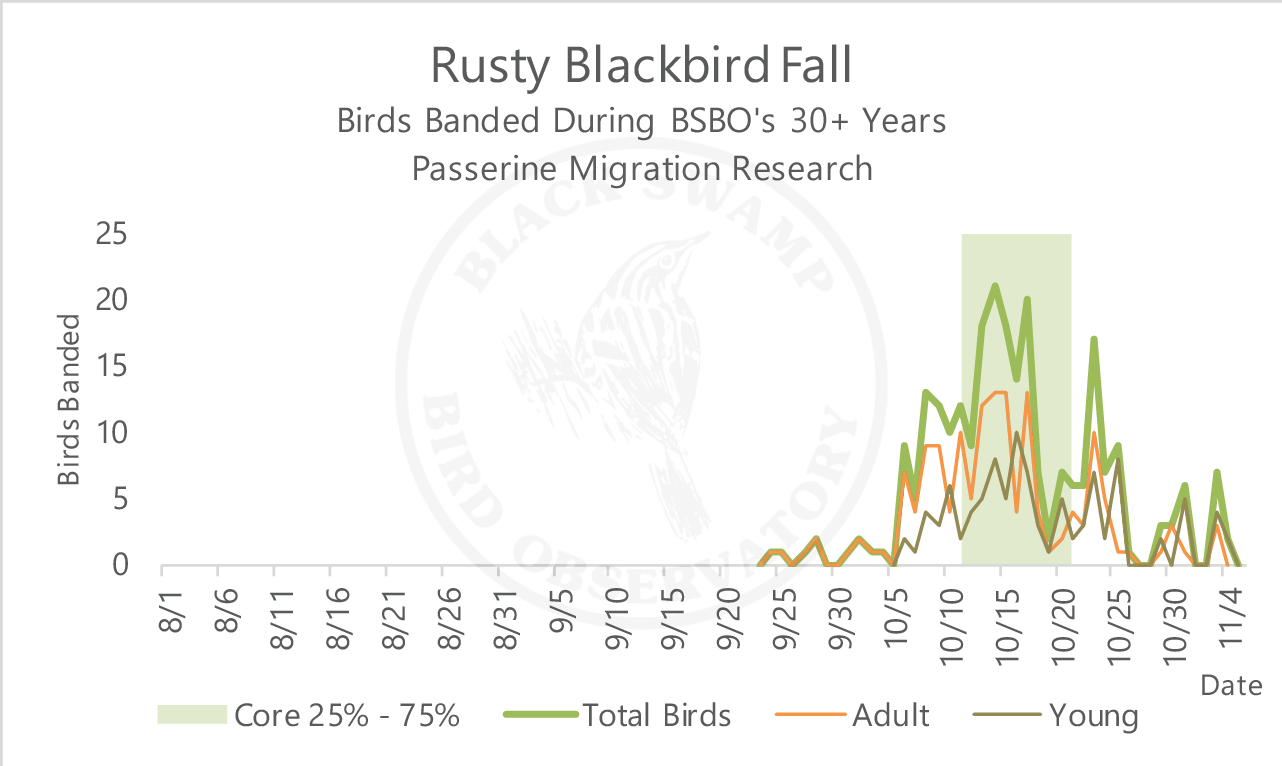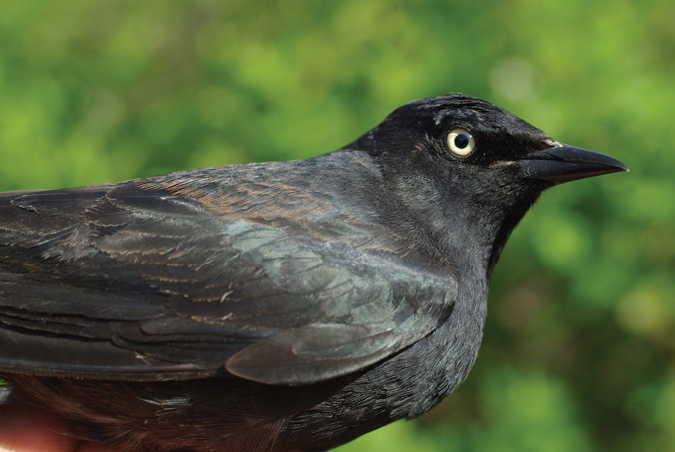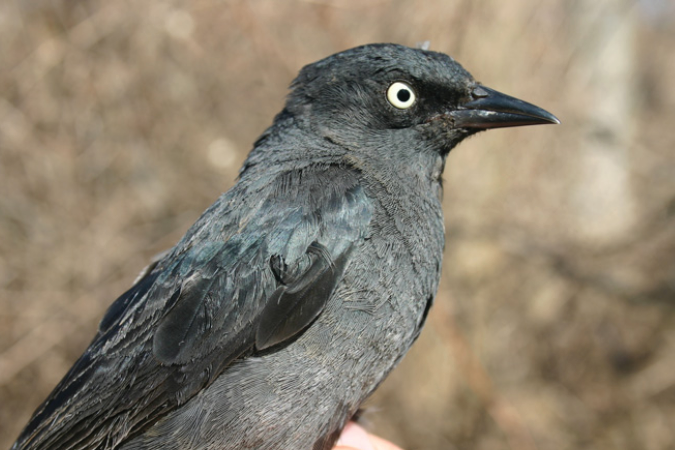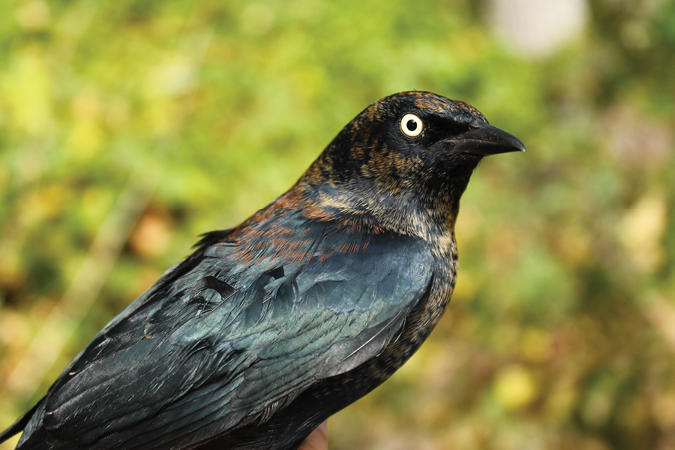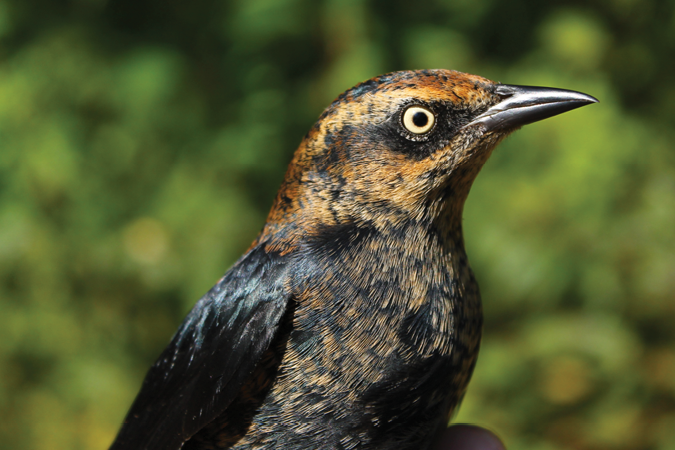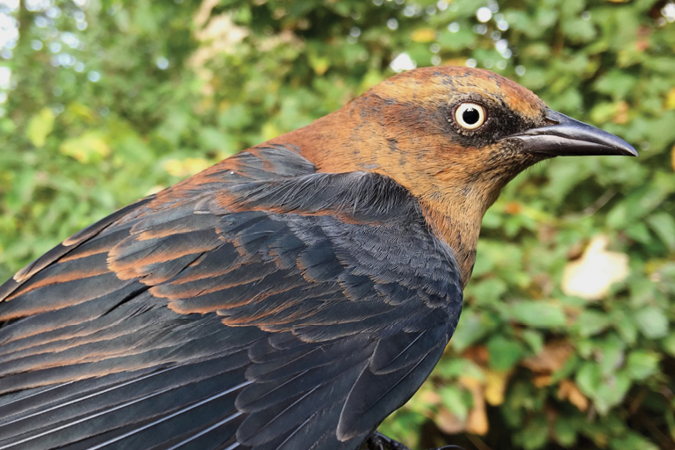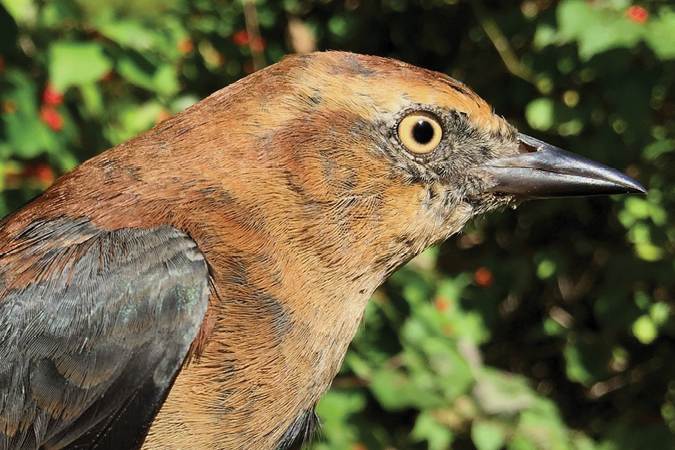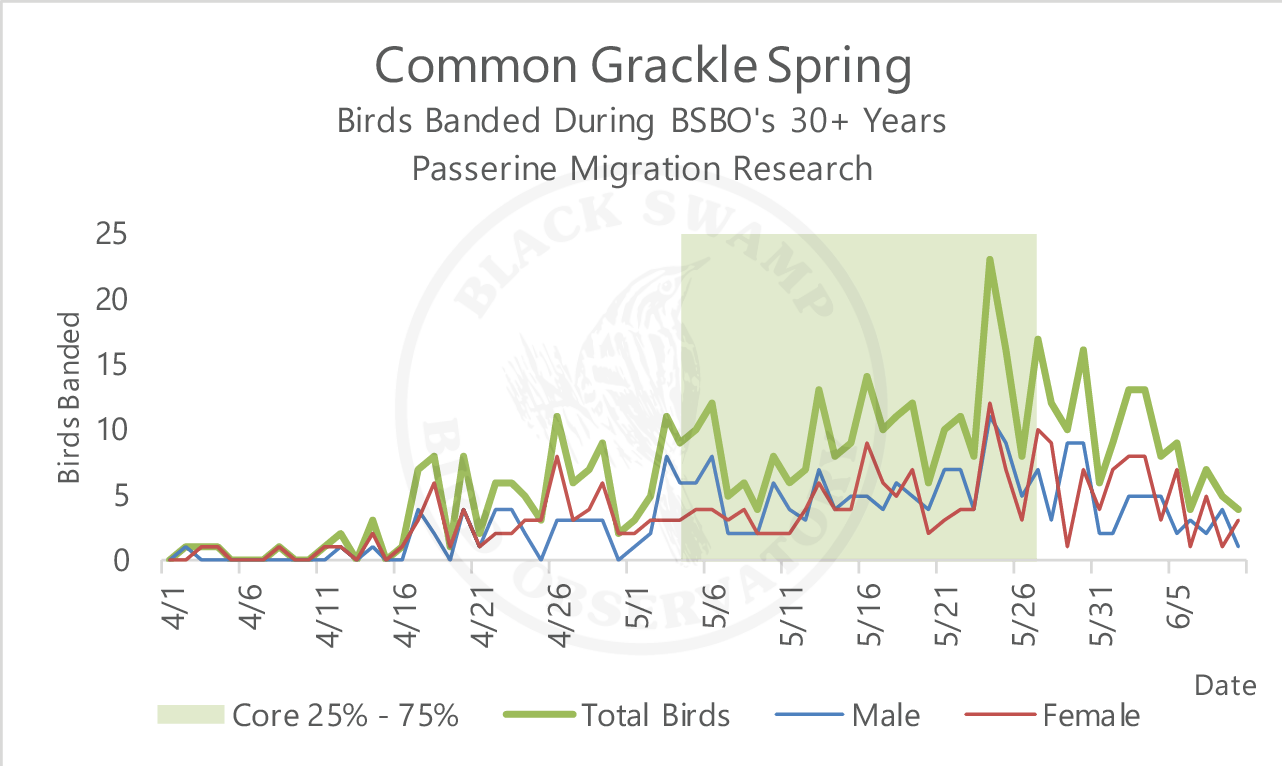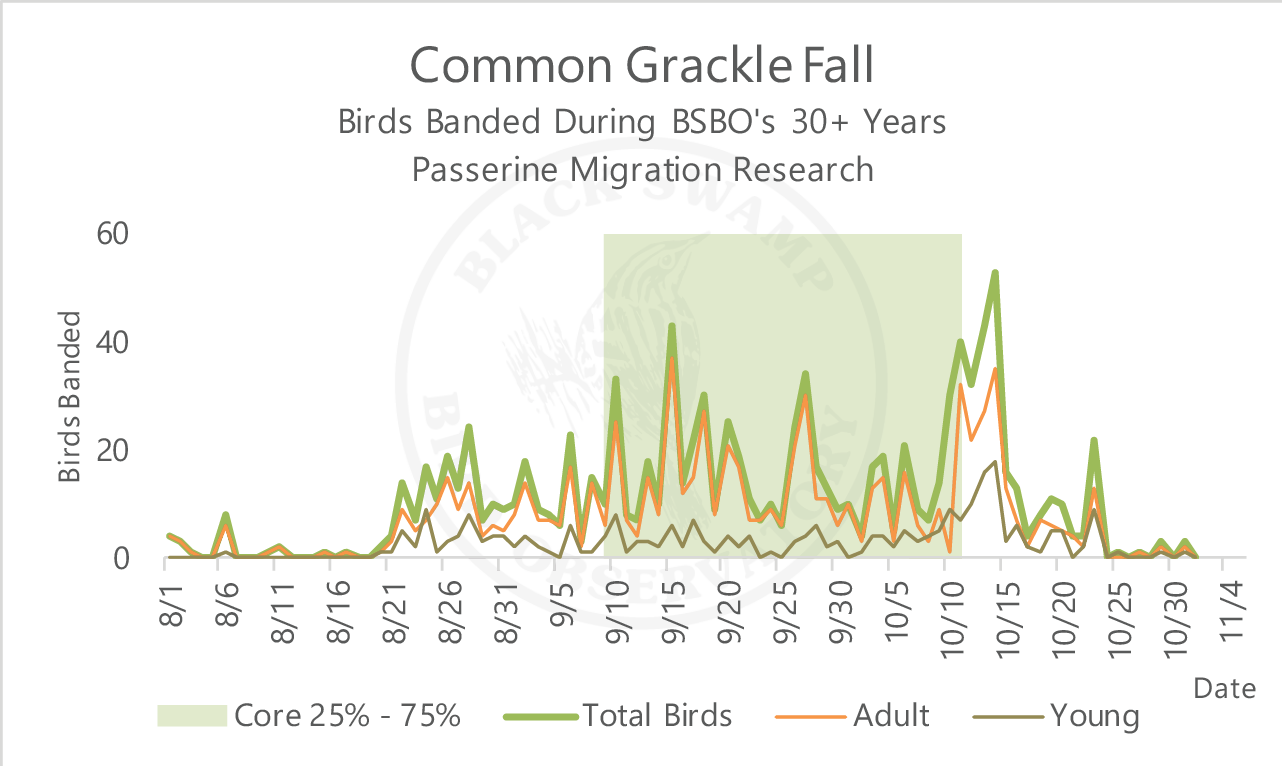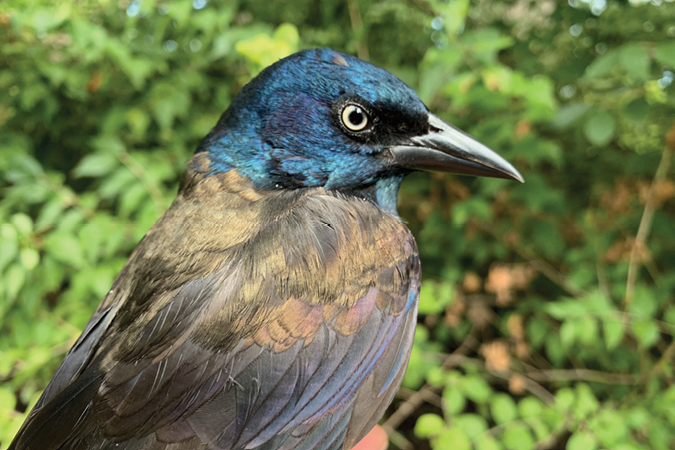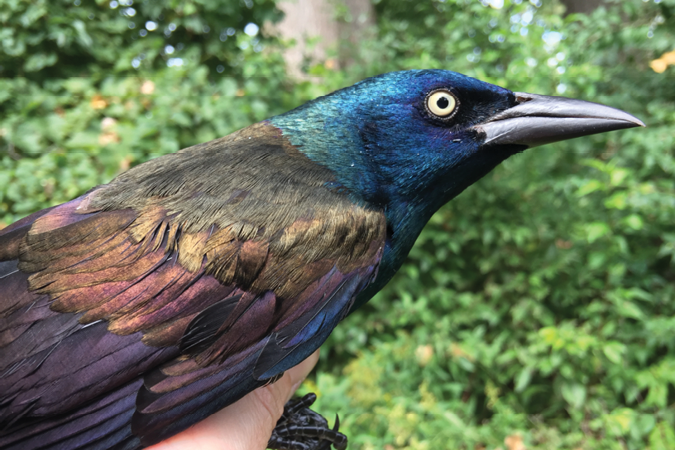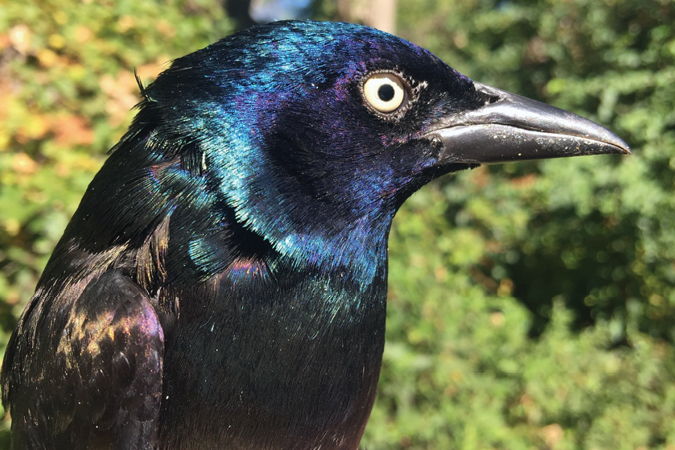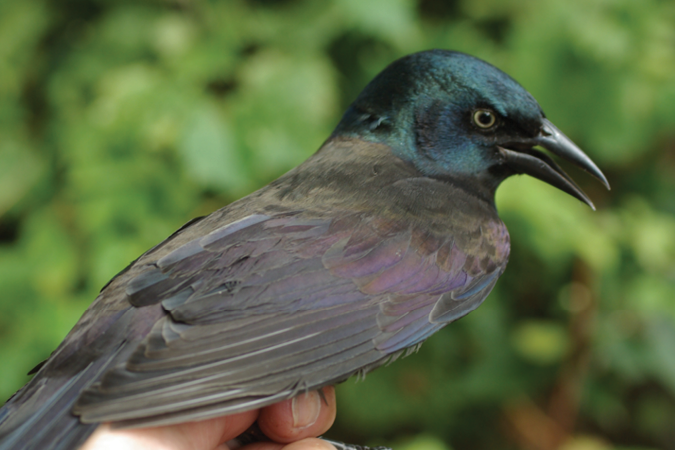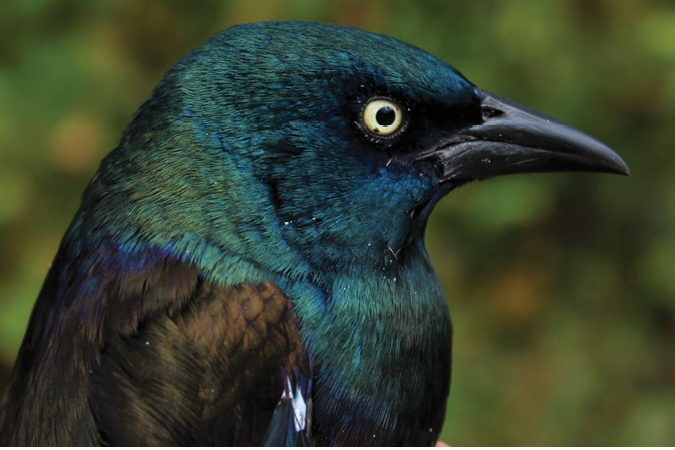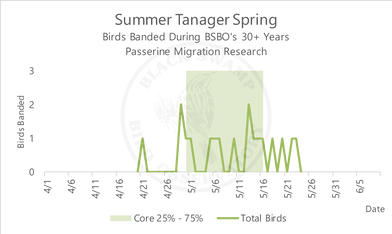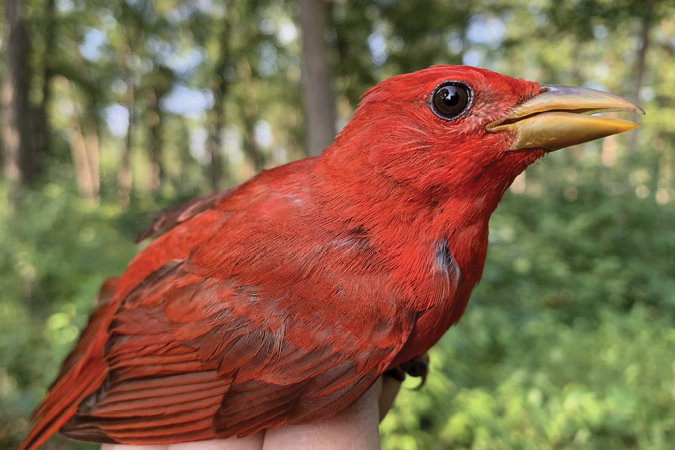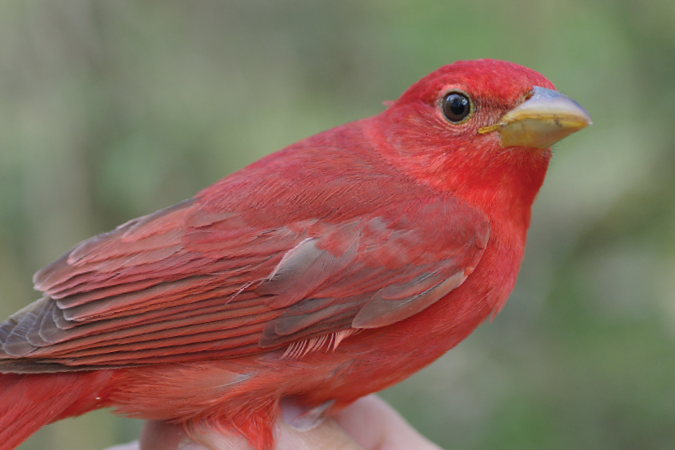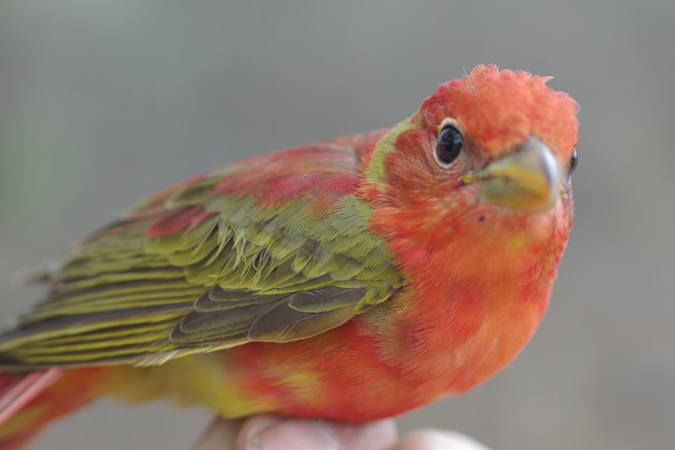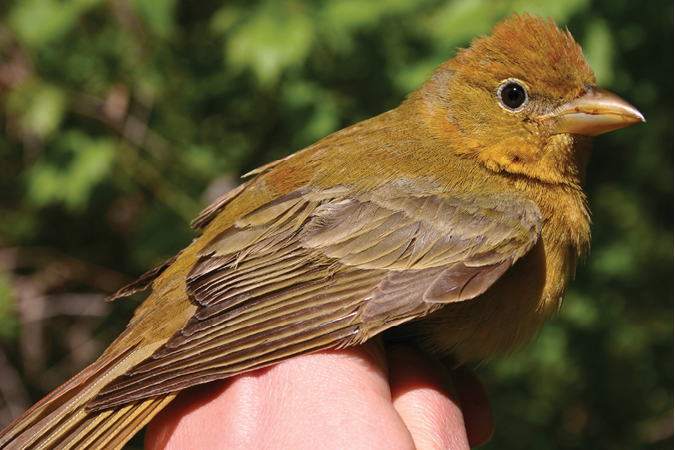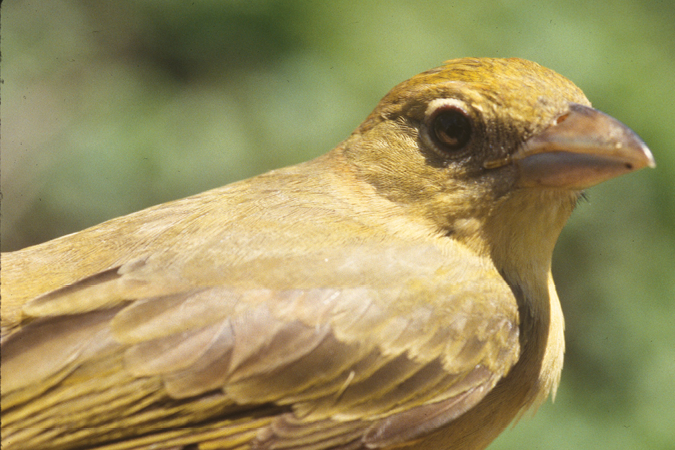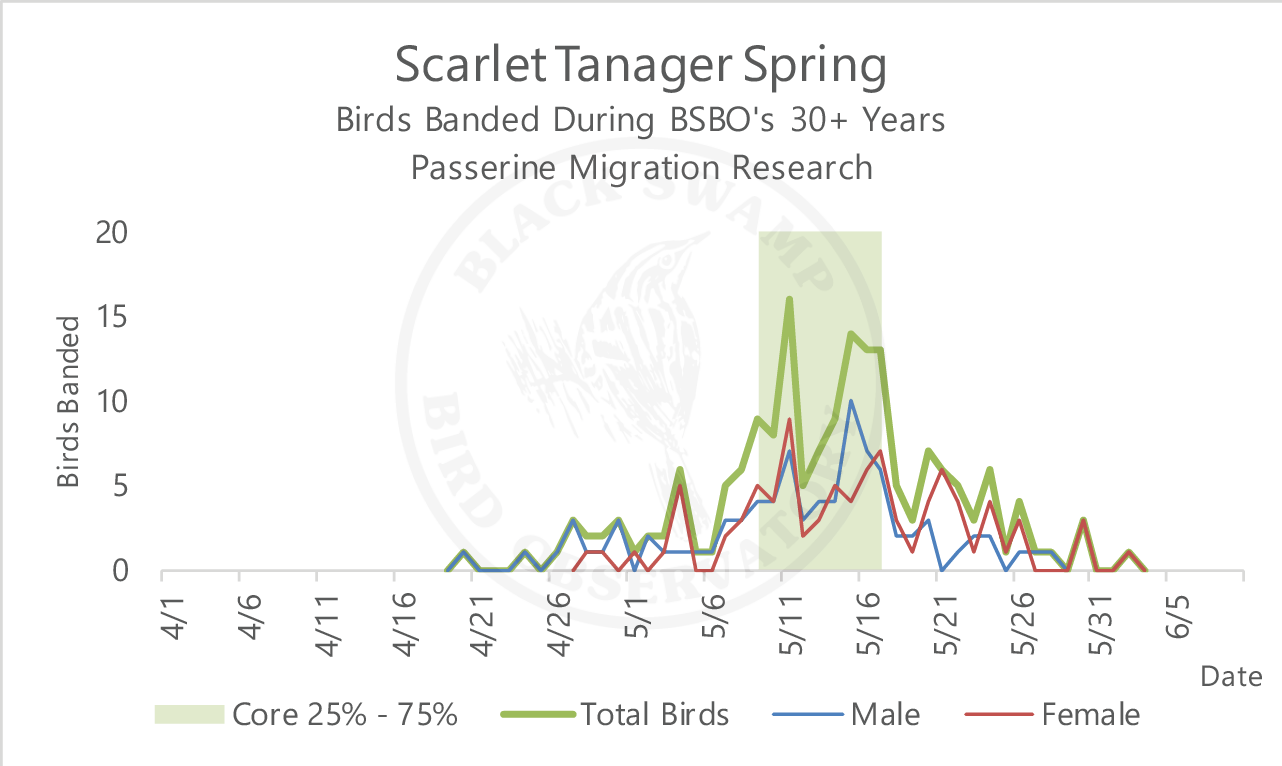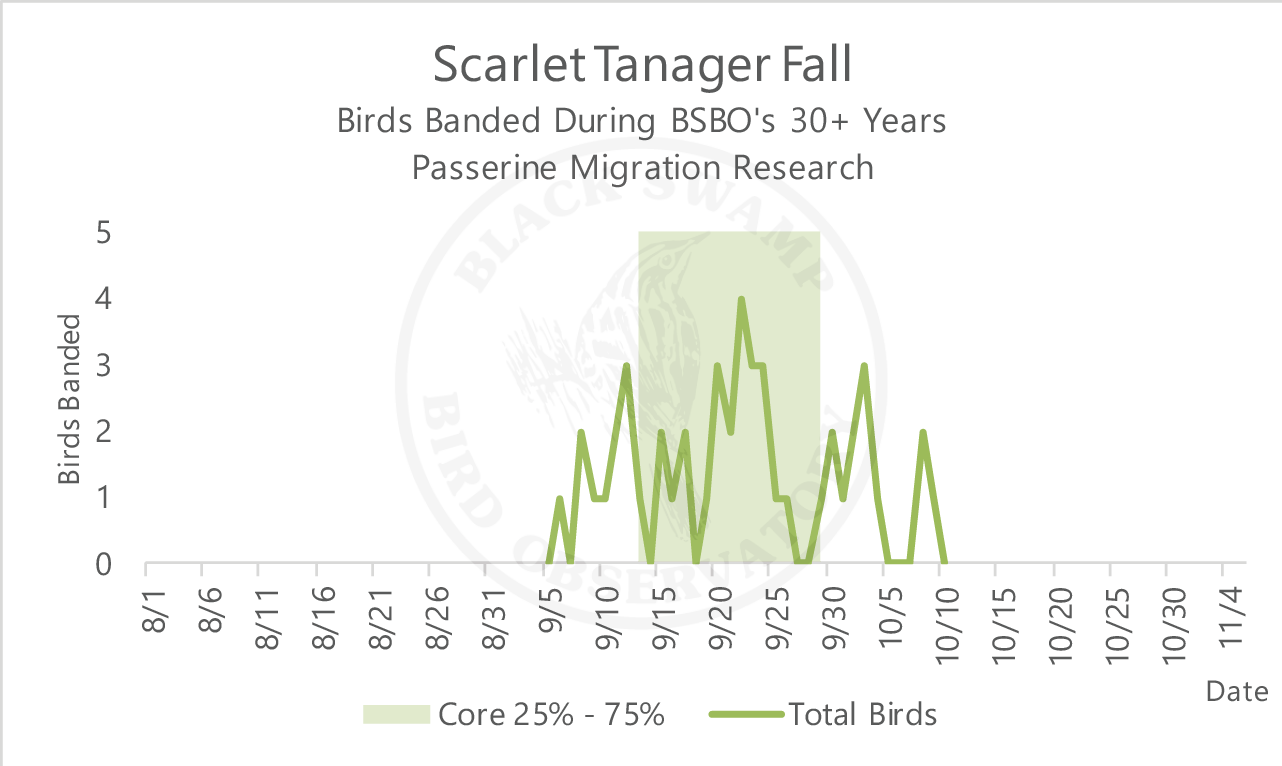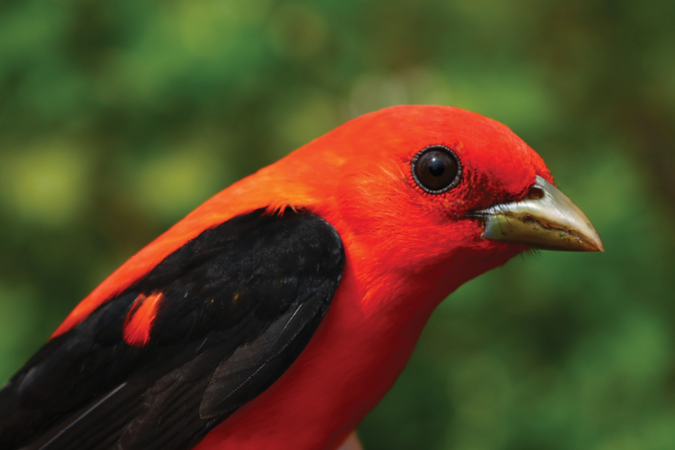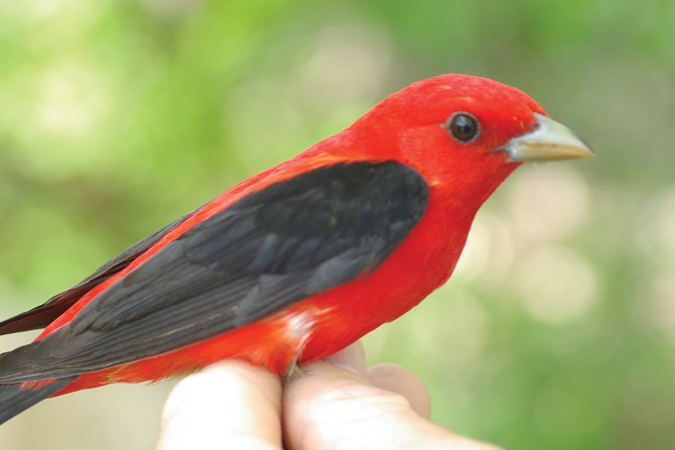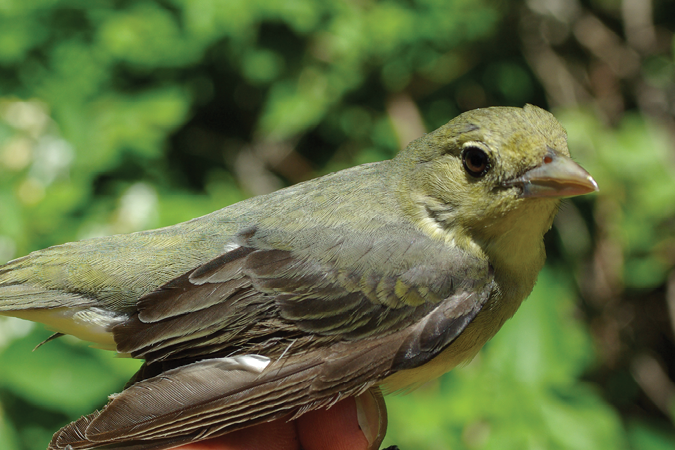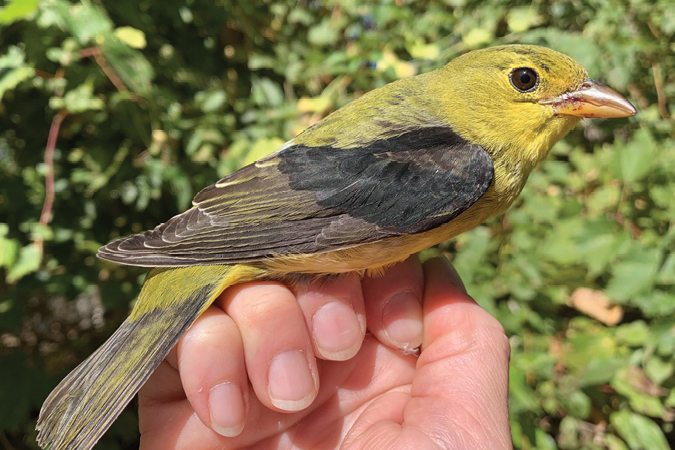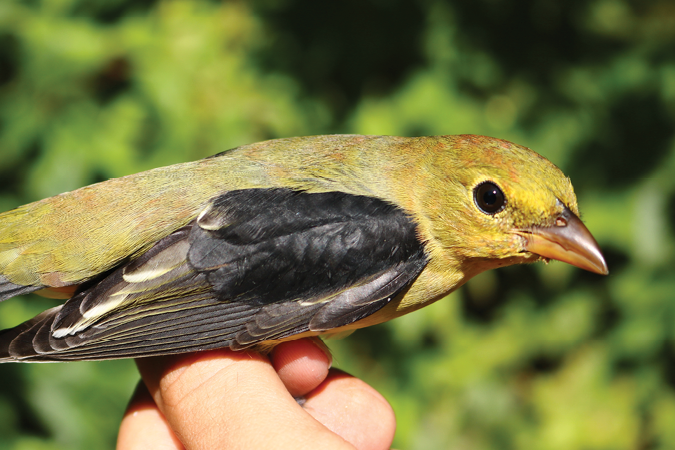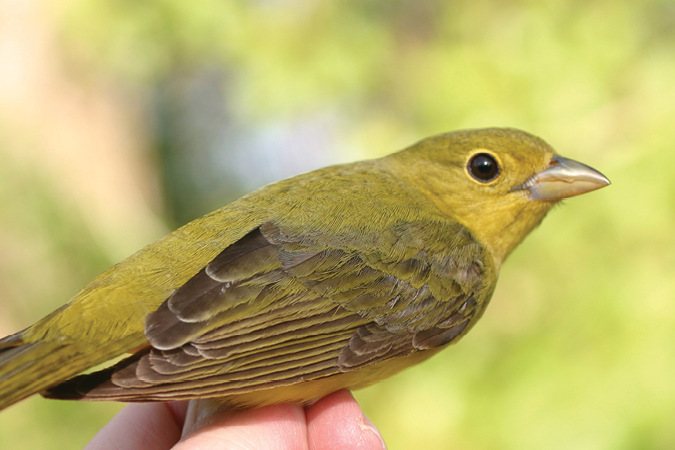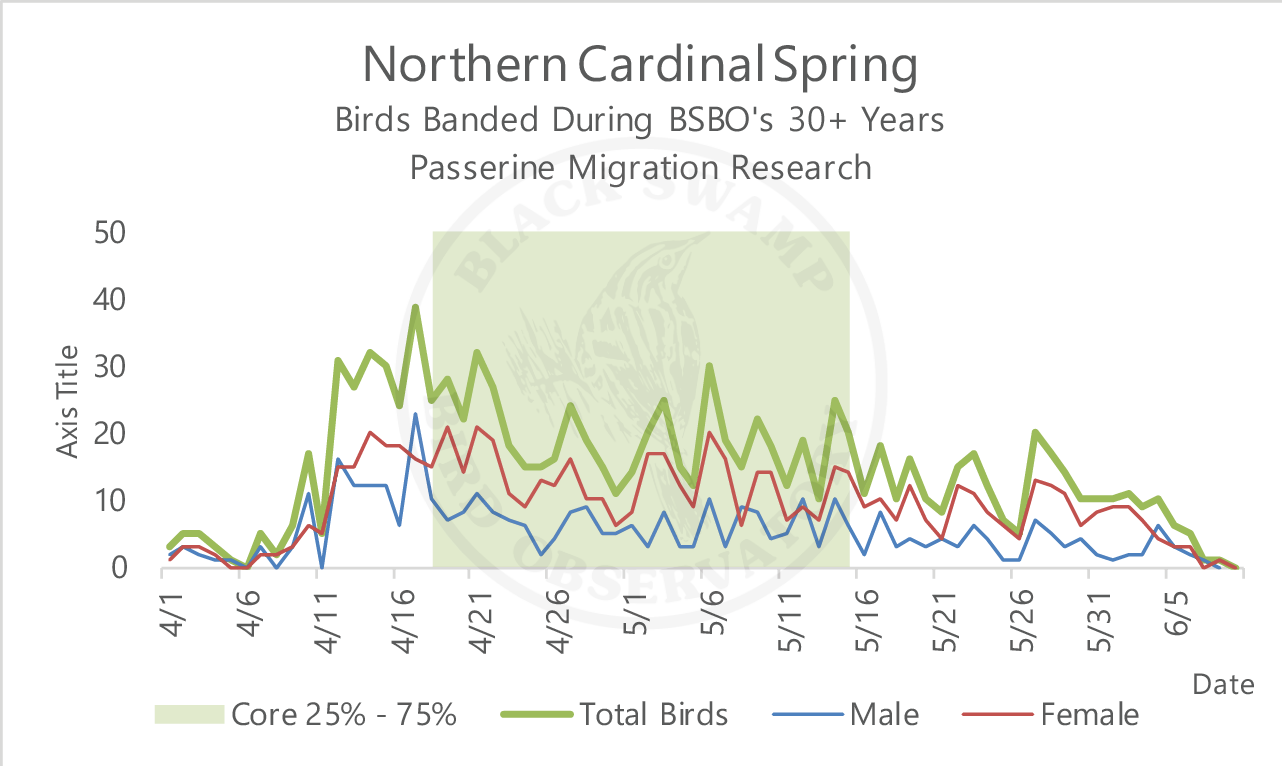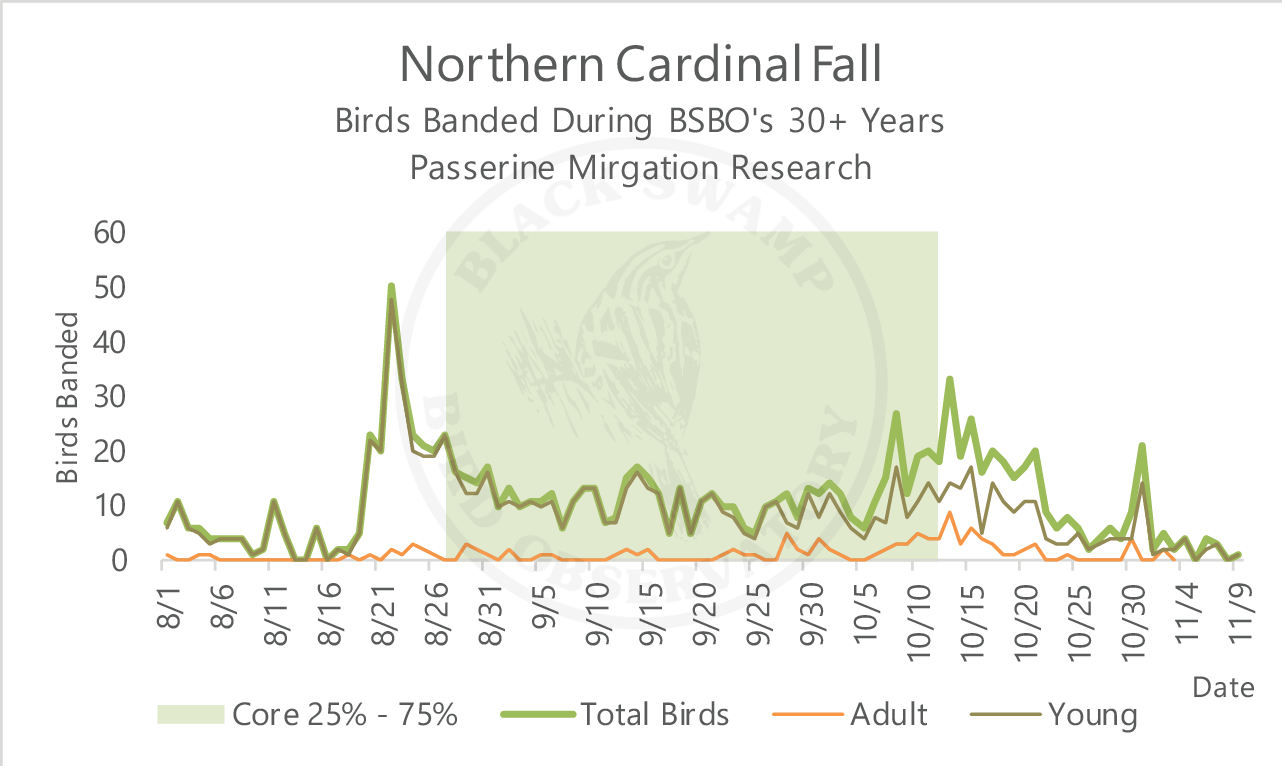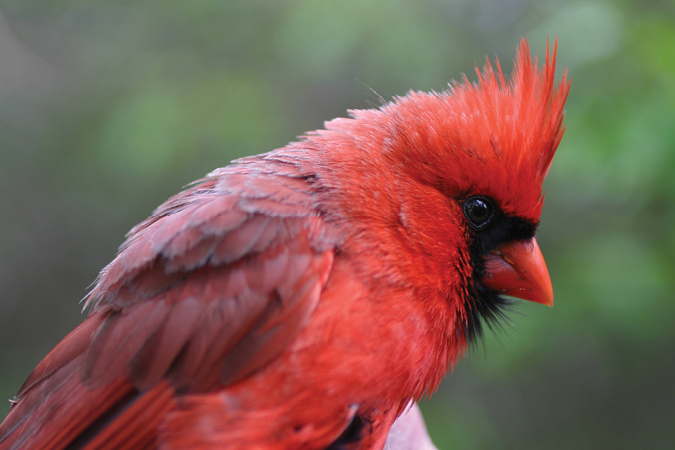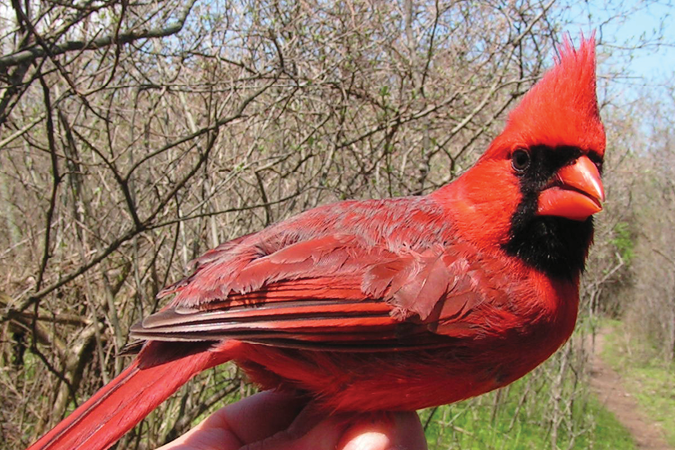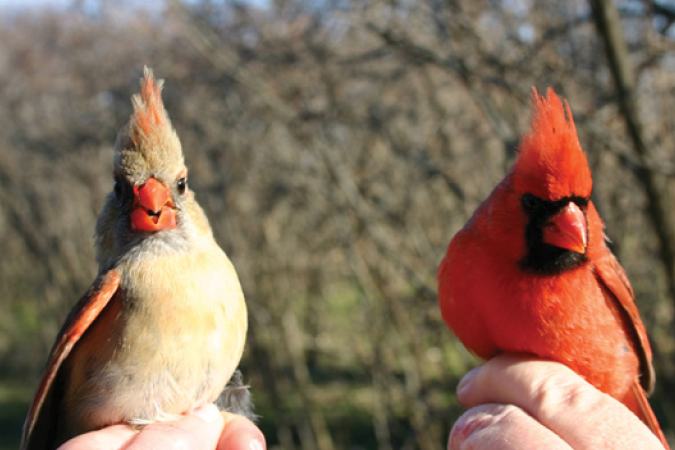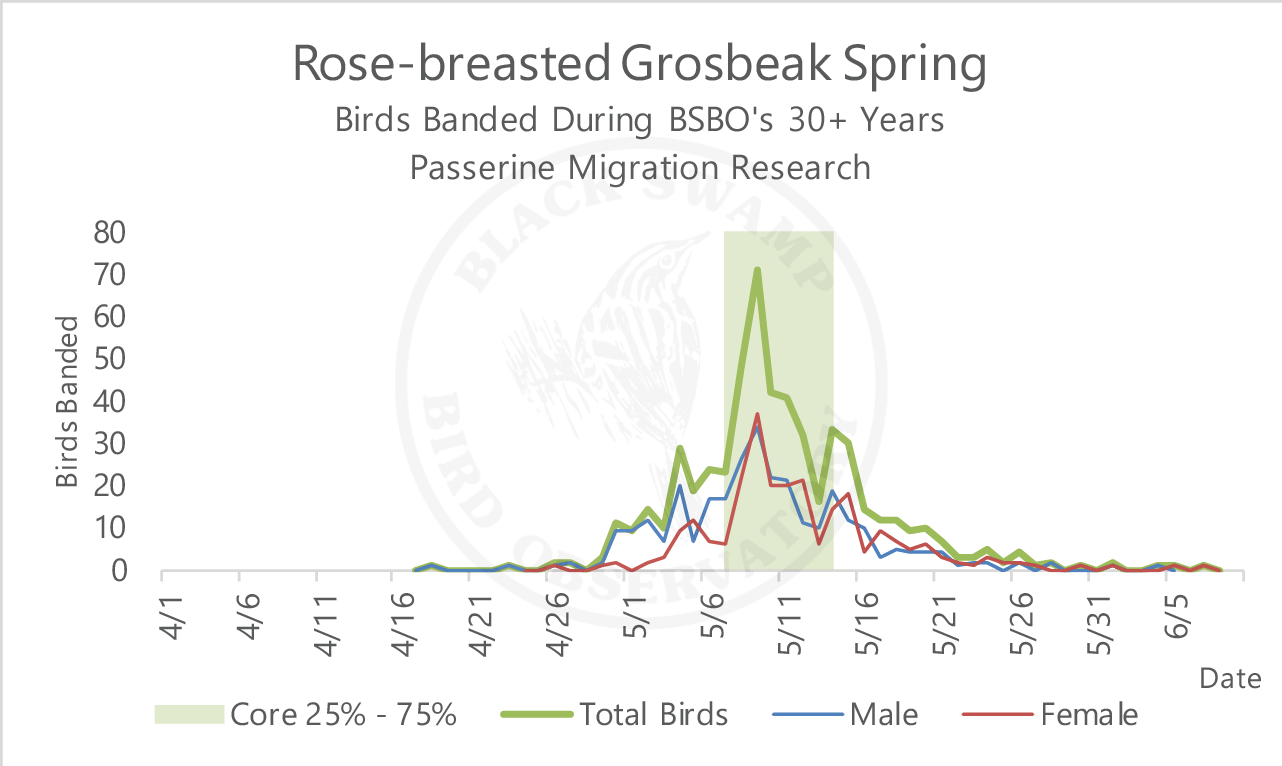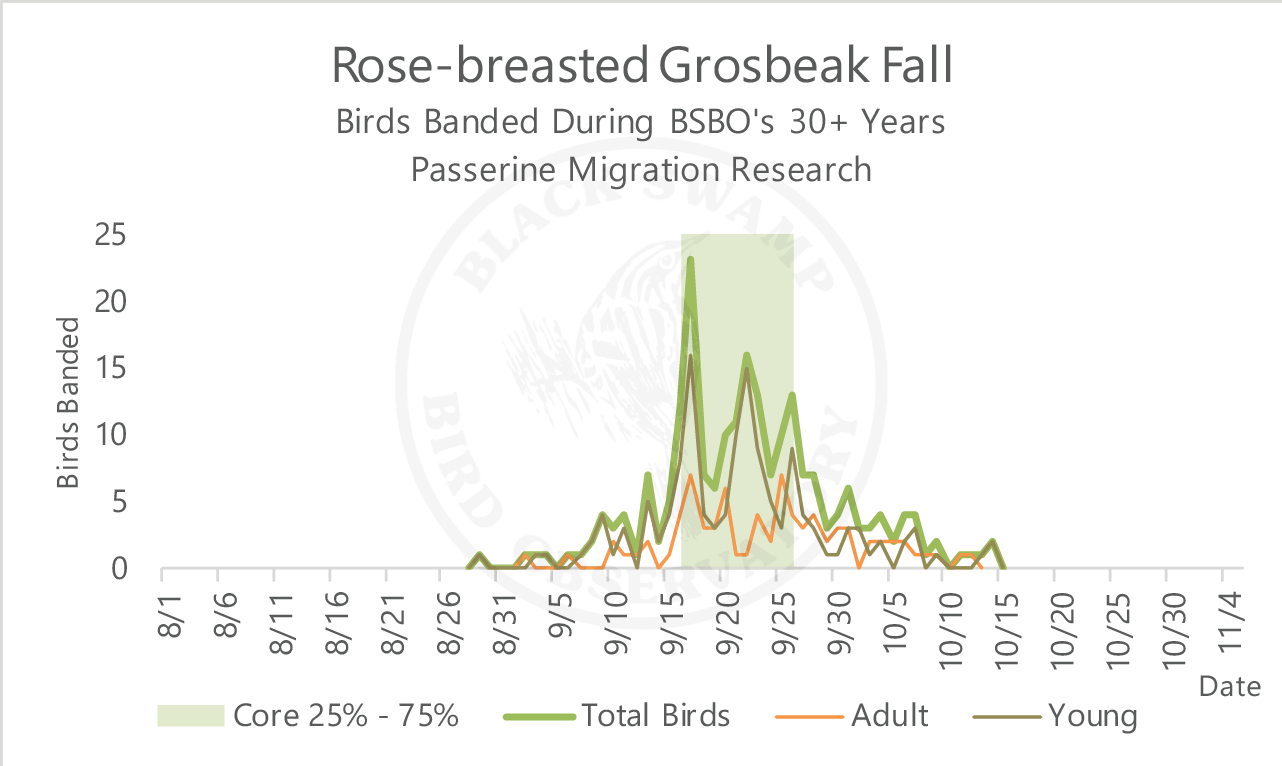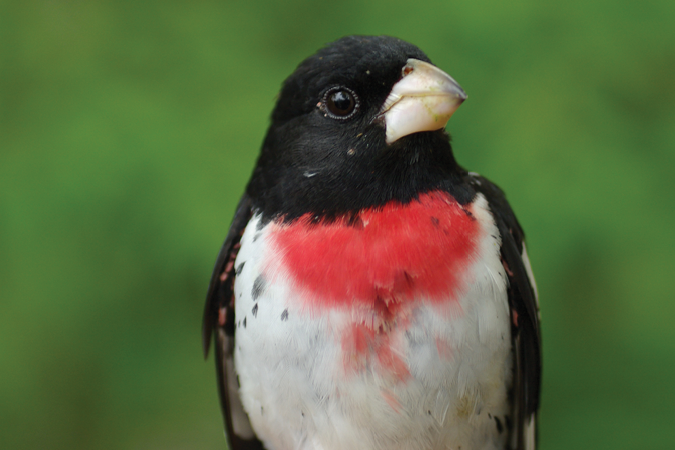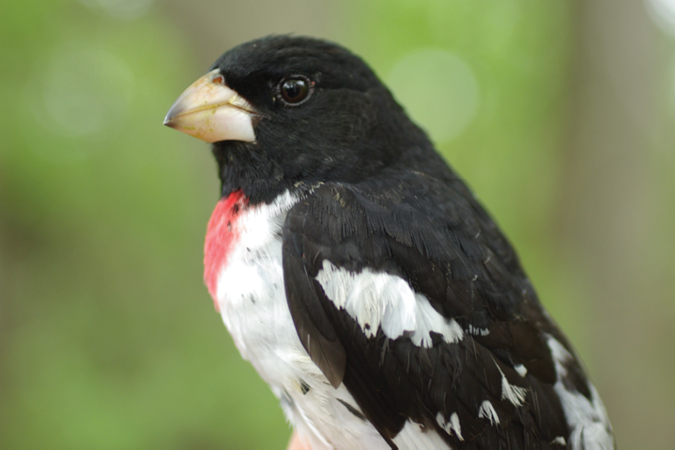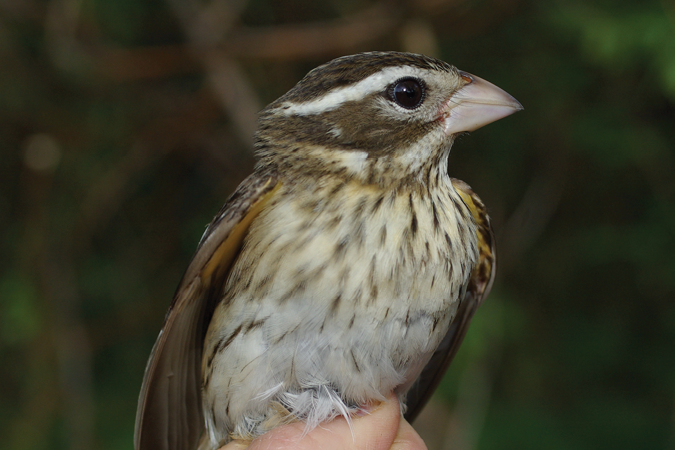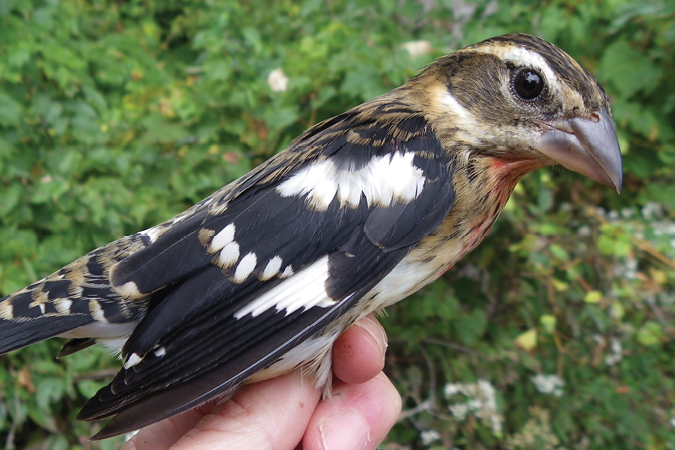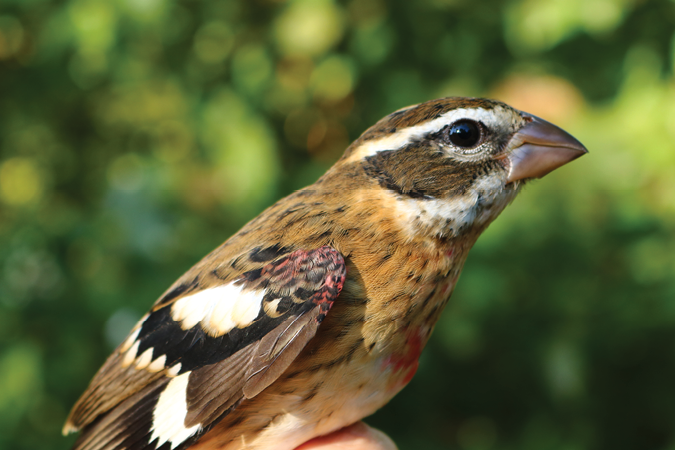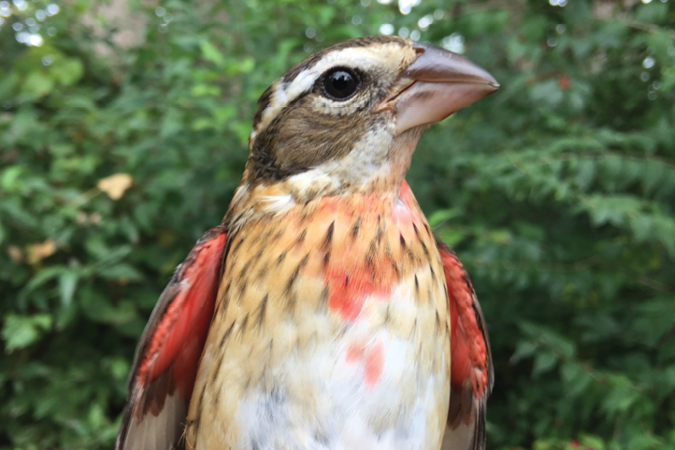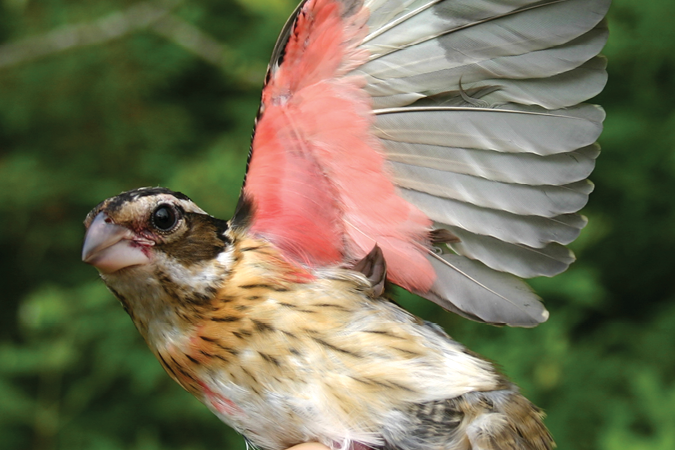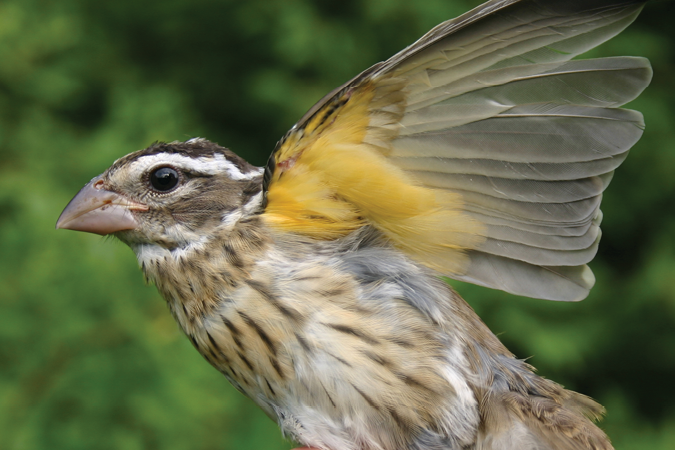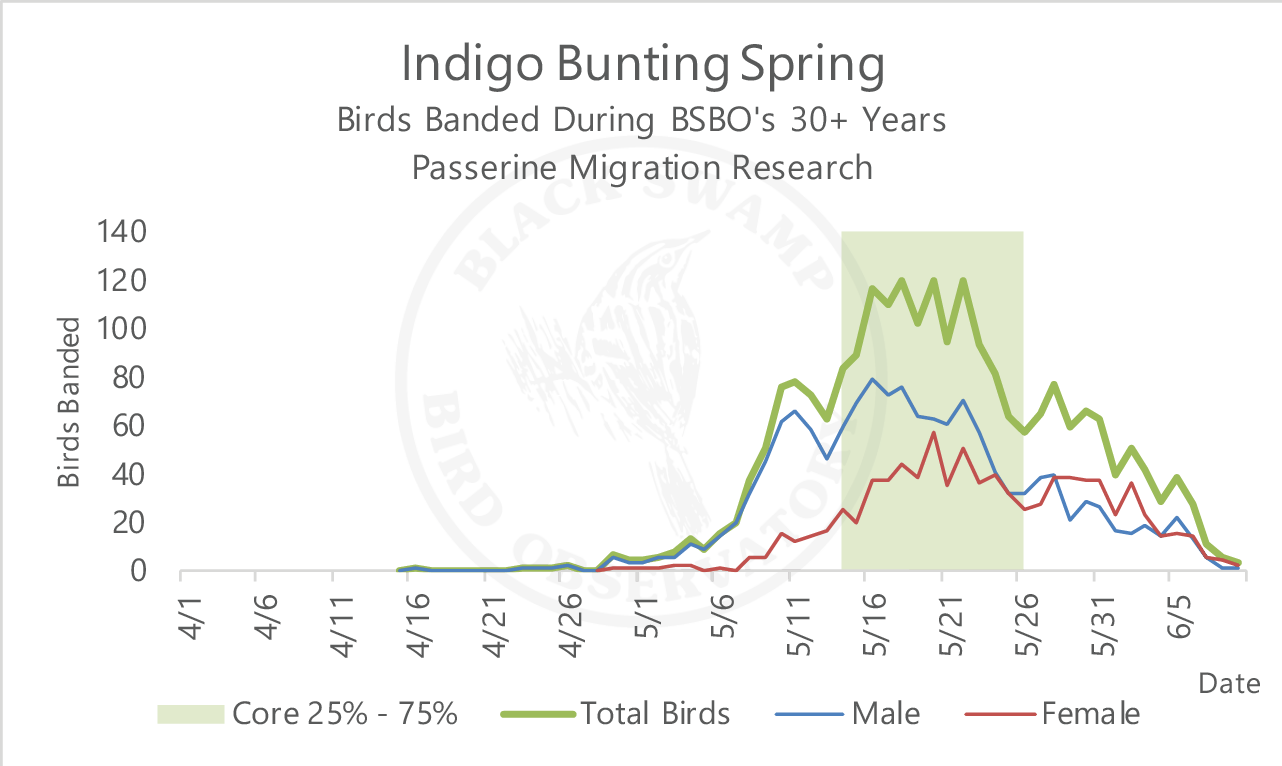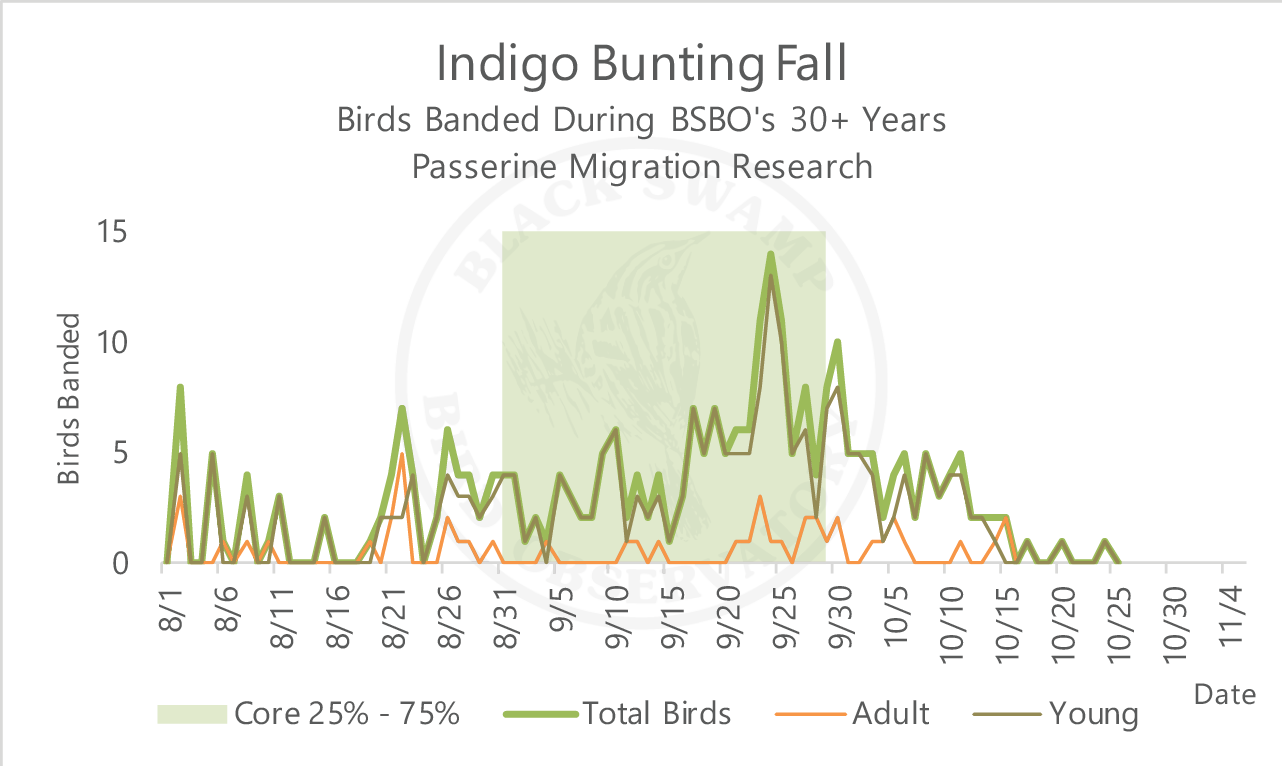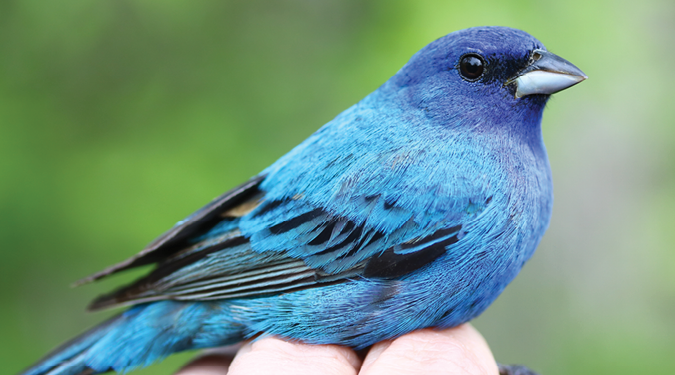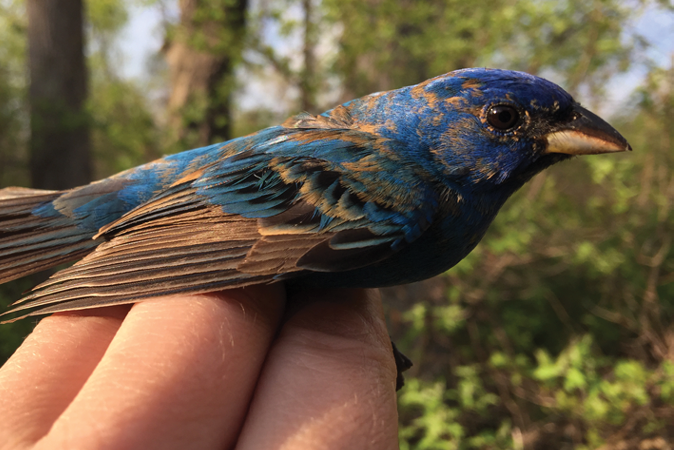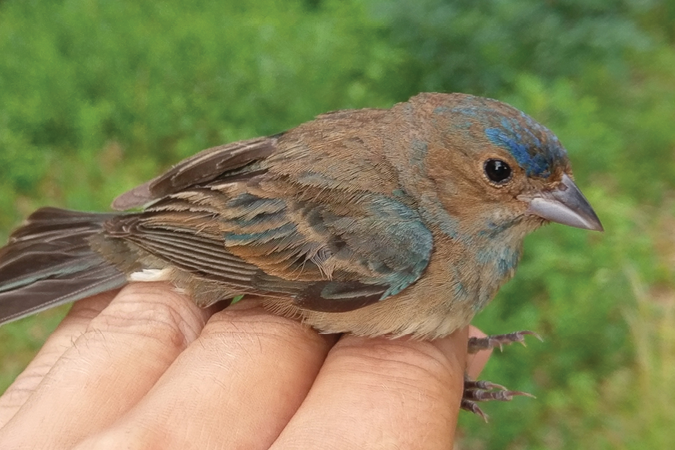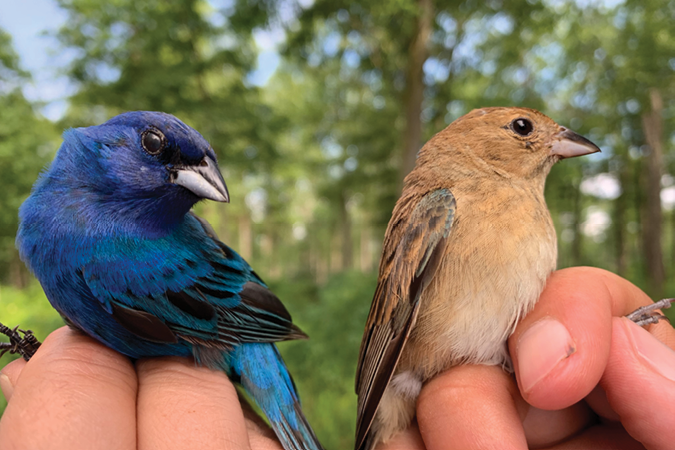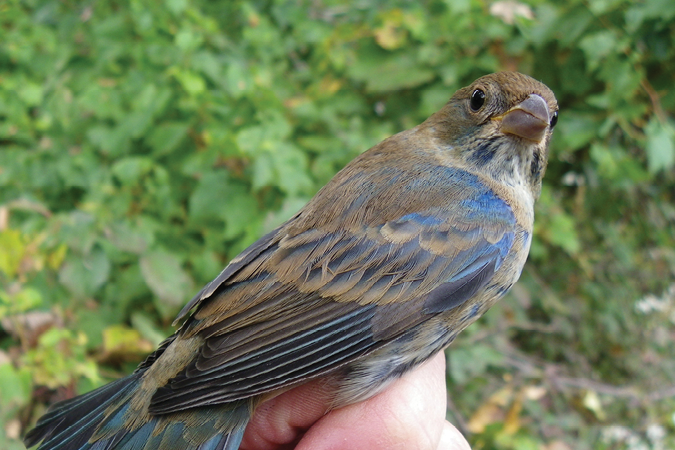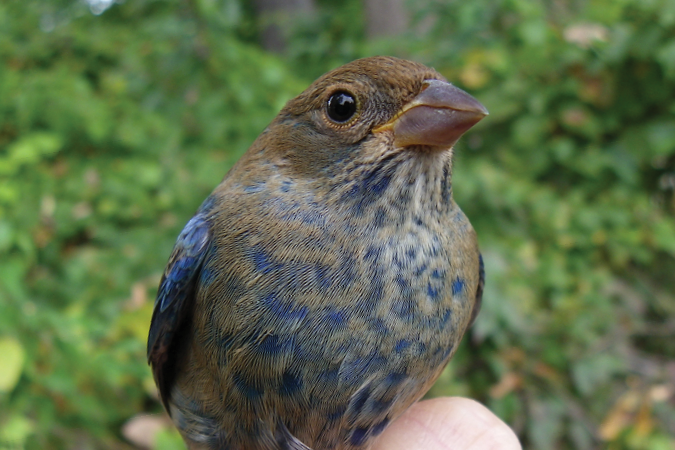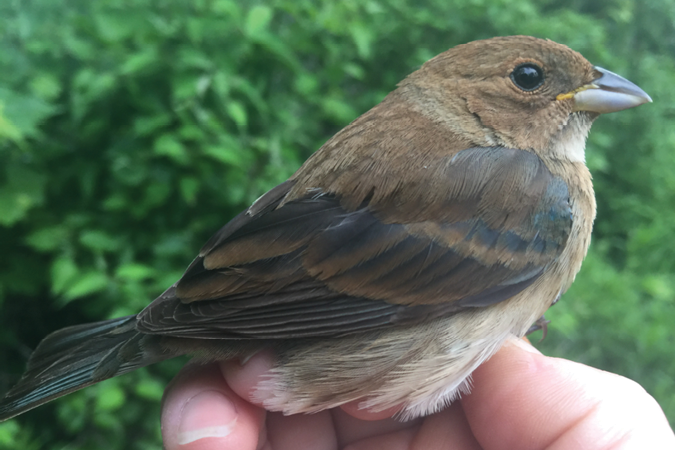Chat Icteriidae
about chat in nw ohio
This is a newly defined family containing only one species, the unique and vocal - yet skulky and wary - Yellow-breasted Chat. This species is uncommon in our region as both a migrant and a breeder. They can be found in brushy woodlands, especially overgrown shrublands and thickets where males can be heard singing enthusiastically from the safety of dense cover. Their songs can be mistaken for those of the mimids due to Yellow-breasted Chat’s wide array of vocalizations, its propensity for repeating phrases, and their ability to imitate neighboring birds and other frequently heard sounds.
Yellow-breasted Chat Icteria virens
|
Alpha Code: YBCH Spanish: Chipe de Pecho Amarillo French: Paruline polyglotte Band Size: 1B ~ 1A ~ 1D NW Ohio Status: Migrant, Breeding-local Total Banded in Spring: 221 Average Banded in Spring: 7 Total Banded in Fall: 23 Average Banded in Fall: <1 |
Song: jumble of harsh, chattering clucks, whistles, squawks, and short repeated phrases
Description: Tannish-olive above with bright yellow throat and breast; white belly and undertail; white eyebrow and eye arc; gray-black mask. Male and female nearly identical but male with black lores and black mouth lining; female with grayish lores and pinkish mouth lining. Spring Migration Timing: Primarily second wave, with early males first appearing in late April and the peak of total birds occurring May 7-19. |
Fall Migration Timing: Sporadic and protracted with birds appearing August through October, with the densest encounters occurring in late August.
Migration Habitat: Dense, brushy tangles and shrubs along the edges of wet habitats, and also open scrub-shrub along forest edges or in open woods. Notes: NW Ohio is at the northern edge of YBCH breeding range (with northern Ohio uncommonly hosting breeding birds) resulting in minimal encounters in spring and even fewer in fall. |
Blackbirds Icteridae
about blackbirds in nw ohio
Perhaps no family of songbirds is more apparent and noticeable in the Great Black Swamp than the icterids. They are numerous, oftentimes gregarious, and while not as ostentatious as the warblers, they demand attention. The family is diverse and includes the blackbirds, grackles, cowbirds, orioles, meadowlarks, and Bobolink. In general, they are medium-sized songbirds with strong bills and feet. Icterids are omnivorous, but their lifestyle often involves the capture and consumption of any small animal they can catch and fit in their bill, from grasshoppers, worms, and beetles, to small fish, frogs, and even nestlings or adult birds of other species. Vocalizations across the family range from sweet whistles and rich warbles to complex squeaks and mimicry. Flocks of blackbirds can number into the tens of thousands and the combination of voices can become deafening at times, particularly during pre-roosting rituals late in the afternoon.
Birders and everyday visitors alike cannot venture outdoors or travel through Northwest Ohio without encountering at least one species from this family nearly year-round. Flocks of Red-winged Blackbirds, Rusty Blackbirds, and Common Grackles begin moving about the landscape in late February to mid-March. Owing to the fact that they are diurnal migrants, their movements across the landscape can be breathtaking spectacles that show just how rich and productive this region really is for wildlife, especially avifauna. In mild years, blackbirds can initiate nesting well before the threat of snow has vanished. In contrast, our orioles are true neotropical migrants, with some individuals venturing all the way to South America during winter.
Eastern Meadowlark (a resident to short-distance migrant) and Bobolink (a breeder and long-distance migrant) are species exclusively found in grasslands and open habitats and are encountered very infrequently at our study site, hence their exclusion from our analysis.
Birders and everyday visitors alike cannot venture outdoors or travel through Northwest Ohio without encountering at least one species from this family nearly year-round. Flocks of Red-winged Blackbirds, Rusty Blackbirds, and Common Grackles begin moving about the landscape in late February to mid-March. Owing to the fact that they are diurnal migrants, their movements across the landscape can be breathtaking spectacles that show just how rich and productive this region really is for wildlife, especially avifauna. In mild years, blackbirds can initiate nesting well before the threat of snow has vanished. In contrast, our orioles are true neotropical migrants, with some individuals venturing all the way to South America during winter.
Eastern Meadowlark (a resident to short-distance migrant) and Bobolink (a breeder and long-distance migrant) are species exclusively found in grasslands and open habitats and are encountered very infrequently at our study site, hence their exclusion from our analysis.
Orchard Oriole Icterus spurius
|
Alpha Code: OROR Spanish: Bolsero Castaño French: Oriole des vergers Band Size: 1B NW Ohio Status: Migrant, Breeding Total Banded in Spring: 50 Average Banded in Spring: 2 Total Banded in Fall: 14 Average Banded in Fall: <1 |
Song: quick musical warble, often interrupted by harsh chatters
Spring Description: Adult male mostly black above with chestnut-orange underparts and wing patch. Female greenish-yellow with dusky wings and two white wingbars. Young male like female but with a black throat. Blue-gray bill and legs. Spring Migration Timing: Primarily appears during the second wave, with peak movements occurring May 8-18. |
Fall Description: Adult male and female same as spring. Young male and female similarly greenish-yellow without chestnut or black. Blue-gray legs and bill.
Fall Migration Timing: Insufficient data to graph. Migration Habitat: Semi-open habitats including forest edges, orchards, urban parks, and backyards. Typically avoids unbroken or dense forests. |
Baltimore Oriole Icterus galbula
|
Alpha Code: BAOR Spanish: Bolsero de Baltimore French: Oriole de Baltimore Band Size: 1A ~ 1B ~ 1D NW Ohio Status: Migrant, Breeding Total Banded in Spring: 1,089 Average Banded in Spring: 36 Total Banded in Fall: 602 Average Banded in Fall: 21 |
Song: flute-like, clear whistled notes, often paired and repeated, lasting 1-2 seconds
Spring Description: Male mostly black above with bright orange underparts and wing patch. Female dusky above varying black flecks throughout face, and pale orange-yellow underparts. Blue-gray legs and bill. Spring Migration Timing: The first early males begin arriving in late April, with a sudden surge in the second wave around May 7. Peak of total birds occurring May 8-19. |
Fall Description: Adult male same as spring. Adult female similar to spring but slightly more brownish. Young birds dusky above with pale yellow-orange underparts and brownish wings. Blue-gray legs and bill.
Fall Migration Timing: Early and condensed, with peak movements occurring August 21-30, and most birds departing by the beginning of September. Migration Habitat: Canopy forager of open woods and shade trees. Prefers the open edges of woods and can typically be found in urban parks and backyards. |
Red-winged Blackbird Agelaius phoeniceus
|
Alpha Code: RWBL Spanish: Tordo Sargento French: Carouge à épaulettes Band Size: M: 2 ~ 1D, F: 1A ~ 1D NW Ohio Status: Present All Year Total Banded in Spring: 4,201 Average Banded in Spring: 140 Total Banded in Fall: 821 Average Banded in Fall: 28 |
Song: loud, rich vic-tor-yyyy!
Spring Description: Male entirely black with red-orange wing patch edged by yellow-gold below. Female brownish above and heavily streaked brown and white below; reduced orange-crimson wing patch; white eyebrow; and peachy face and throat. Spring Migration Timing: Consistent throughout spring with many males arriving in winter and April. Females begin arriving in early April, increasing by May. |
Fall Description: Adult male similar to spring but with slight bronze edging to some black feathers. Adult female same as spring. Young birds similar to adult female, but lacking wing patch, and generally with a whitish face and throat. Young male gaining black body feathers and orange wing patch by the end of fall.
Fall Migration Timing: Two distinct peaks occur as birds begin flocking August 21 through September 9 and again form into flocks around October 1 in preparation for winter dispersal. Migration Habitat: Can appear in a variety of habitats including brushy fields, mudflats, and backyard feeders, but prefers marshes and other swampy areas. Notes: RWBL show an increase of activity in spring following egg laying as females infiltrate habitats adjacent to theirs nests to forage. In fall, activity initially spikes in August as young birds begin to utilize more of the landscape. Another spike occurs in October following a brief disappearance in which molt completes and birds form into sex-specific flocks. |
Rusty Blackbird Euphagus carolinus
|
Alpha Code: RUBL Spanish: Tordo Rojizo French: Quiscale rouilleux Band Size: 2 ~ 1D NW Ohio Status: Migrant, Winter Total Banded in Spring: 132 Average Banded in Spring: 4 Total Banded in Fall: 316 Average Banded in Fall: 11 |
Song: quick garble of notes, followed by a higher rising whistle like the squeak of a rusty hinge
Spring Description: Male entirely black with a glossy hint of purple, blue, and green. Female matte charcoal-black. Whitish eyes. Spring Migration Timing: Movement actually begins in March with flocks roaming throughout the landscape into April. Lingering birds remain in the region into May, with peak movements occurring April 18-29. |
Fall Description: Males similar to spring except with rusty-butterscotch edges to back, breast, and head feathers; and young male showing a mostly rusty face. Females with butterscotch-rusty back, breast, and head; and matte, charcoal-gray belly. Whitish-amber eyes.
Fall Migration Timing: Late and condensed, with activity picking up in early October and peak movement of birds occurring October 11-21. Migration Habitat: Prefers to pick through leaf litter of wet or swampy woods, but will occasionally stray into open fields with other blackbird flocks. |
Common Grackle Quiscalus quiscula
|
Alpha Code: COGR Spanish: Zanate Norteño French: Quiscale bronzé Band Size: M: 3 ~ 3B, F: 3 ~ 2A NW Ohio Status: Migrant, Breeding, Winter-uncommon Total Banded in Spring: 553 Average Banded in Spring: 18 Total Banded in Fall: 1,293 Average Banded in Fall: 45 |
Song: variety of clucks, screeches, whistles, and creaks, typically accompanying a squeaky readle-ak
Description: Male entirely black with glossy tones of purple and blue on head; and subtler purple, blue, and olive-bronze throughout body. Female entirely black-brownish with glossy tones of green and blue on head; and subtle green, purple, blue, and olive-bronze throughout breast and upper back. Whitish eyes. Spring Migration Timing: Consistent throughout spring with many males arriving in late winter and April. Females begin arriving in early April, increasing by May. |
Fall Migration Timing: Begin forming roaming flocks by late August and remain consistent throughout fall. COGR show peak activity leading up to mid-October when they quickly depart the region.
Migration Habitat: Favors open and semi-open areas including farmlands, neighborhoods, and groves; but also common in urban parks and along woodland edges. |
Cardinals and Allies Cardinalidae
Abour cardinals & allies in nw ohio
One of our most colorful and charismatic families, the cardinalids include the state bird of Ohio, Northern Cardinal, as well as the New World buntings, grosbeaks (with the exception of Evening Grosbeak, which is a finch), and almost all of the birds named “tanager” that occur in the US and Canada. All of these species show distinct dimorphism between males and females, with males often being bright red, blue, or sporting a striking pattern and splashed with color. Females are clad in gorgeous browns and yellows, with green, subtle blue, and red accenting their plumage yet not betraying them during nesting and incubation. All of the cardinalids are migratory in our area, including Northern Cardinal to some degree.
Summer Tanager Piranga rubra
|
Alpha Code: SUTA Spanish: Tangara Roja French: Piranga vermillon Band Size: 1A ~ 1B NW Ohio Status: Overflight Migrant, Breeding-local Total Banded in Spring: 20 Average Banded in Spring: <1 Total Banded in Fall: 0 Average Banded in Fall: - |
Song: sweet, slurred whistles similar to American Robin; distinctive pi-ticky-tuck call
Description: Male entirely strawberry red. Female yellow-orangish with dusky yellow wings. Young male in fall and spring yellow with varying amounts of red. Spring Migration Timing: Primarily second wave, with peak overflights occurring in late April through mid-May. |
Fall Migration Timing: Insufficient data to graph.
Migration Habitat: Slow canopy forager of open woods (particularly oak forests) but will utilize forest edges. Notes: Mostly a breeder of far southern Ohio, the occurrence of SUTA along the lake shore is mostly accidental. However, the Oak Openings region hosts breeding SUTA and some birds encountered near Lake Erie may be making their way west. |
Scarlet Tanager Piranga olivacea
|
Alpha Code: SCTA Spanish: Tangara Escarlata French: Piranga écarlate Band Size: 1B NW Ohio Status: Migrant, Breeding-local Total Banded in Spring: 197 Average Banded in Spring: 7 Total Banded in Fall: 51 Average Banded in Fall: 2 |
Song: hurried, blurry warble, somewhat like American Robin; distinctive chick-burr call
Spring Description: Male electric red (mixed with green in younger birds) with black wings. Female yellow-green with dusky olive-black wings. Spring Migration Timing: Primarily second wave, with early males first arriving in late April, and peak total bird movement occurring May 10-17. |
Fall Description: Adult male yellow-green with black wings. Young male yellow-green with black and brownish-black wings. Females yellow-green with dusky olive-black wings.
Fall Migration Timing: Encountered through September into mid-October with peak movements occurring in late September, 15-30. Migration Habitat: Canopy forager of forests and shade trees (particularly oak) but will move into lower vegetation in open areas and on cold days. |
Northern Cardinal Cardinalis cardinalis
|
Alpha Code: NOCA Spanish: Cardenal Norteño French: Cardinal rouge Band Size: 1A stainless steel NW Ohio Status: Present all year Total Banded in Spring: 1,215 Average Banded in Spring: 41 Total Banded in Fall: 1,349 Average Banded in Fall: 47 |
Song: loud, rich whistle sweet-sweet-sweet or birdie-birdie-birdie
Description: Male entirely scarlet red with black mask and throat. Female warm tan with reddish wings, tail, and crest. Spring Migration Timing: Begin moving around the landscape in March (away from their chosen winter sites), settling into breeding territories by April. Breeding birds begin foraging farther away from nest-site following nest building and egg laying in late April, showing an initial surge of activity in spring. |
Fall Migration Timing: Two distinct peaks with local birds moving heavily through the area in late August; a second peak through early and mid-October suggests migrant NOCA moving across the landscape.
Migration Habitat: Found commonly and in a wide variety of habitats (predominantly semi-open areas) including forest edges, thickets, urban parks, and backyards. Notes: While considered permanent residents, some amount of migratory behavior (perhaps more than apparent) can be seen in NOCA as they move to more resource-available areas for winter and birds banded later in fall are seldom recaptured at the same location. |
Rose-breasted Grosbeak Pheucticus ludovicianus
|
Alpha Code: RBGR Spanish: Picogordo de Pecho Rosa French: Cardinal à poitrine rose Band Size: 1A stainless steel NW Ohio Status: Migrant, Breeding Total Banded in Spring: 724 Average Banded in Spring: 24 Total Banded in Fall: 238 Average Banded in Fall: 8 |
Song: rich, sweet whistle similar to American Robin; distinctive, sharp chink call similar to a sneaker on a gym floor
Spring Description: Male with black head, back, tail, and wings; white underparts, wing patches, and rump; rosy pink triangular breast patch and wingpits. Female brown above with orange-tan underparts and brown streaking; yellow wingpits; white eyebrow above brown face. Spring Migration Timing: Second wave with males first arriving by May 1, and peak total bird movement occurring May 7-15. |
Fall Description: Male brown above with black wings and tail (young male with black and brown wings); orange-tan to white below with hints of red in breast; red wingpits; white eyebrow above dark brown face. Female same as spring.
Fall Migration Timing: Quite condensed with birds filtering through around September 1, with a sudden peak movement September 16-27. Migration Habitat: Canopy forager of open woods and groves, but will move lower into adjacent scrub-shrub, backyards, and even to feeders. |
Indigo Bunting Passerina cyanea
|
Alpha Code: INBU Spanish: Colorín Azul French: Passerin indigo Band Size: 1 ~ 0 NW Ohio Status: Migrant, Breeding Total Banded in Spring: 2,719 Average Banded in Spring: 91 Total Banded in Fall: 335 Average Banded in Fall: 12 |
Song: rapid, excited warble what! what! where? where? see it! see it!
Spring Description: Male entirely indigo blue with blue-black wings (younger males mixed blue and brown). Females entirely warm tan with varying speckles of blue. Spring Migration Timing: Early males can first start arriving in late April, but surge around May 10. Total bird movement occurs May 15-26. |
Fall Description: Adult male entirely warm-tan with varying speckles of blue and blue-black wings. Adult female same as spring. Young birds similar to adult female with some young males showing hints of blue.
Fall Migration Timing: Quite prolonged with birds from the local area initially moving in early August and migrants from outside the area picking up by late August extending into late October. Peak movement of total birds occurring September 1-29. Migration Habitat: Brushy areas along forest edges and fields, but also in forest clearings and backyards. |
